
- Switzerland
- The Netherlands
- National Parks
- Affording Travel
- Photography
- Responsible Travel
- Worldschool
- Wanderlust Guides
- Travel Planning
- Work with Us

Hawaii , North America , Travel
How to visit the molokai leper colony – kalaupapa hawaii.
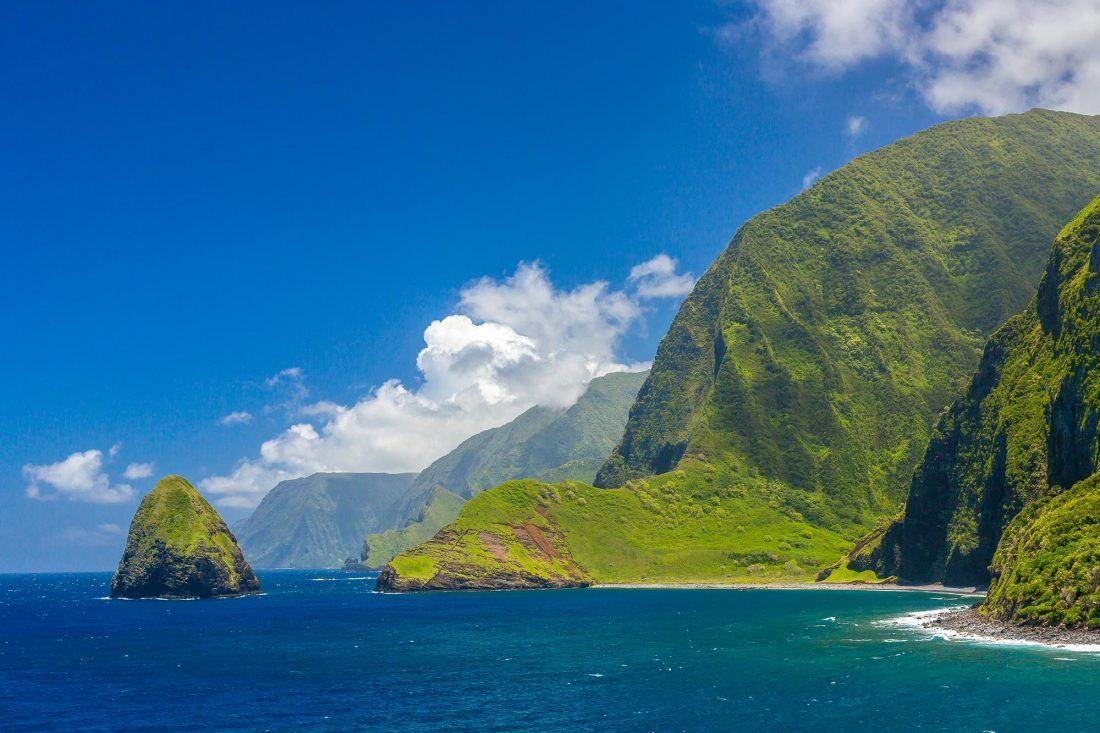
It was one of those places that you visit that never really leaves you. I think about it often and plan to go back someday.
This trip all started out with a book. I love to read, especially books about places I’m traveling to or places I live in. I happened to be living in Hawaii at the time, and my sister recommended this Molokai book to me. I read the book and was blown away by the tragic, and little-known story of the Molokai Leper Colony called Kalaupapa.
Set in Hawaii more than a century ago, Molokai tells the tale of a little girl named Rachel who lives a happy life on the island of Oahu, until one day a red mark appears on her body. She discovers she has leprosy (actually called Hansen’s disease) and, at the age of 7, is sent off, alone, to the island of Molokai Leper Colony known as Kalaupapa where she will spend the rest of her life. There is also a sequel by the same author called Daughter of Molokai.

It’s a tale of tragedy, heartbreak, forgiveness, and love. The fictional part of this book is very moving, but what moved me, even more, was learning of this place for the first time in my life. How could I not have known about this terrible time or place in history? I knew that I had to see this place with my own eyes and learn more about this tragic history.
History of the Molokai Leper Colony Kalaupapa
Kalaupapa Molokai was first opened in 1866. Over the course of more than a century, more than 8,000 victims of Hansen’s disease lived and died here. The disease was introduced to the Hawaiians, who had no immunities to this, from visiting outsiders. There was no prevention or treatment for Hansen’s disease, so isolation seemed like the best solution to stop the spread of the dreadful disease. This law was carried out by King Kamehameha V.
Victims of the disease were transported to the colony by boat, in a cattle pen, after being forcefully taken from their homes. There was no way to leave the colony, except by boat, or scaling the 1700 foot sea cliffs. Supplies only came to the island once every year.
From a resident on Kalaupapa:
“One of the worst things about this illness is what was done to me as a young boy. First, I was sent away from my family. That was hard. I was so sad to go to Kalaupapa. They told me right out that I would die here; that I would never see my family again. I heard them say this phrase, something I will never forget. They said, ‘This is your last place. This is where you are going to stay, and die.’ That’s what they told me. I was a thirteen-year-old kid.”
Many residents of Kalaupapa did move on with their lives while on the colony. Some even got married and had children, however, any children born on Kalaupapa had to be taken away and put up for adoption or sent to a children’s home on Oahu to prevent them from contracting the disease.
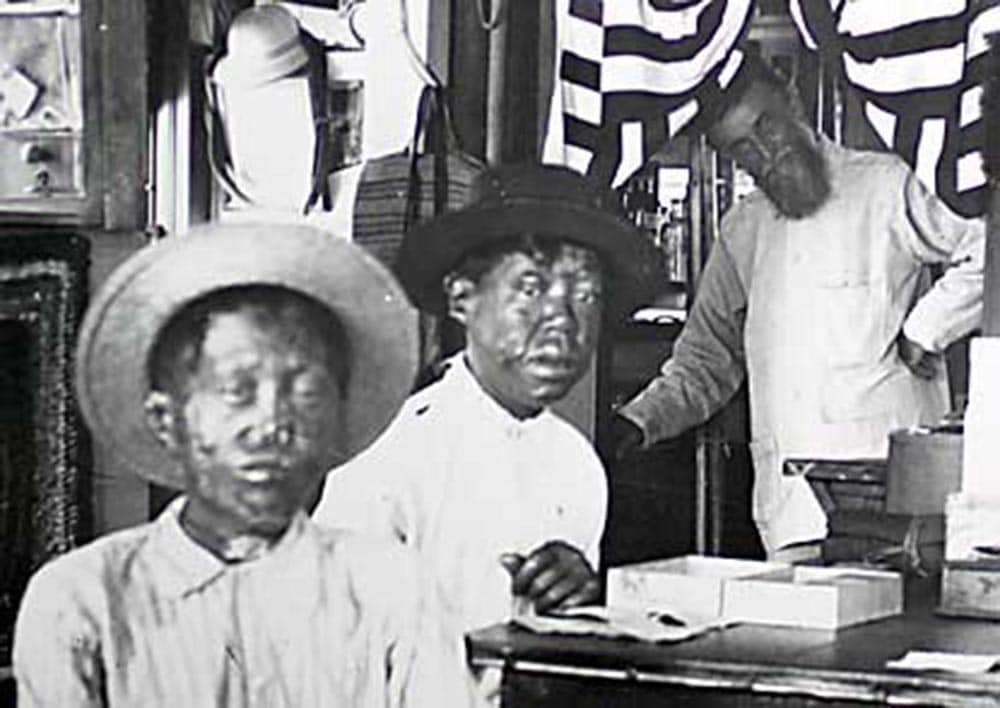
“You know, the babies that were born inside here were not allowed to stay with their parents. After the babies were born, the law said they had to be taken away to the baby nursery in Kalaupapa. They were afraid of the contact—afraid the babies would catch the disease from their parents…. But some of my children, I will tell you this, some of them I kept longer. Most times, the babies were born in the night. We kept everyone quiet so the administrators and nurses would not hear the baby being born. All my babies were born in my own home, right here.”
St marianne and st damien of molokai.
Alongside the tragedy of Kalaupapa were stories of incredible courage and sacrifice. Father Damien, a Catholic priest, came to the colony to care for and minister to the residents. He ended up contracting Hansen’s disease and dying there. He gave his life in service of these people.
Marianne Cope, a religious sister from Germany, also came to Kalaupapa to care for the needy. She never contracted the disease.
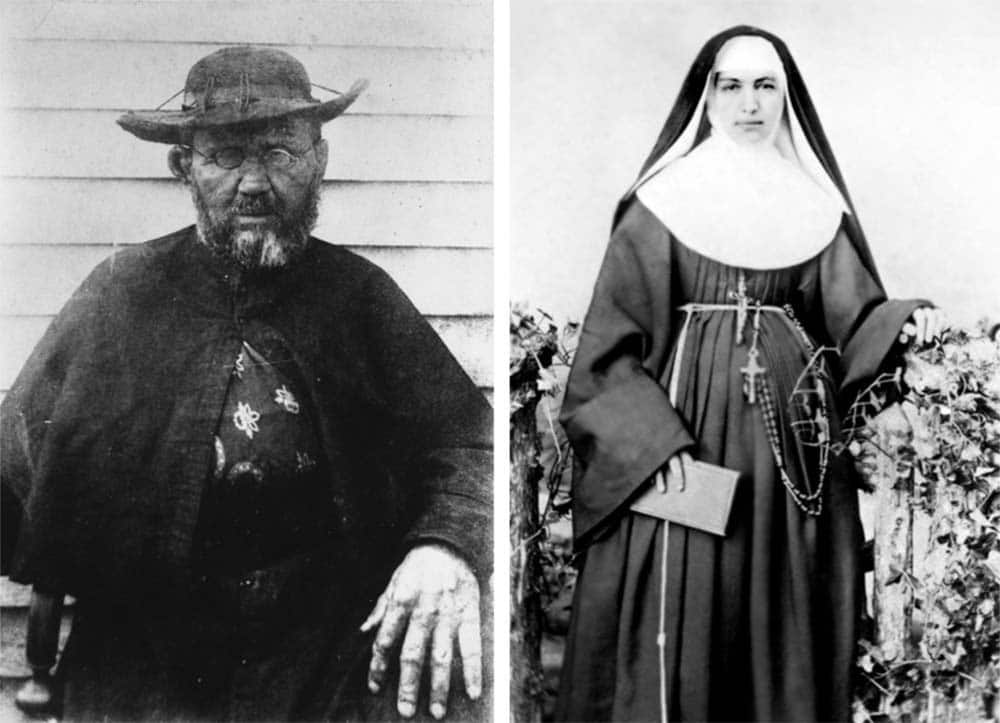
Kalaupapa Today
The Kalaupapa leper colony is no longer a prison for those afflicted by Hansen’s disease but is now a refuge for the now-cured remaining residents who were forced to live their entire lives in isolation.
The colony has now been turned into a National Historical Park. Kalaupapa National Historic Park is located in an isolated section of the island of Molokai, at the bottom of the steepest sea cliffs in the world! Honestly, even without its fascinating history, Kalaupapa’s beauty alone would be enough to attract visitors. This part of the island is so untouched that it feels like stepping back in time.
But you can’t just visit the Molokai Leper Colony on a whim! There is a lot of planning involved, but this trip is so worth your time and effort!
Planning Your Visit to the Molokai Leper Colony: Kalaupapa
Just as in the 1800s, getting to the Kalaupapa leper colony is no easy task! It requires a lot of advanced planning. Here are some good things to know:
- You must obtain a permit in advance to enter Kalaupapa
- You must be 16 years or older to visit
- There are no medical facilities
- There are no food or shopping conveniences
- Pack your own lunch and water
- Pack out your own trash
- Photography of residents or property is strictly prohibited (and rude)
- There is no overnight accommodation
- You must be in good physical condition to visit due to the strenuous nature of the trip
Obtaining a Permit for Kalaupapa National
If you visit Kalaupapa, you must first obtain a permit for visiting. You can do this by booking with the tour company. When you come to the colony, you can only visit with a guided tour run by Damien Tours LLC. They will take you around the area in an old school bus while teaching you about the tragic past of this special place.
How to get to Molokai Kalaupapa Leper Colony
*NOTE: You must book your Permit/Tour AND a way to get there separately.
Once you have booked your tour and obtained your permit, it’s time to decide how you want to get to the Molokai leper colony. You have three options:
- On Foot : Hike down the Kalaupapa Cliffs. The trail to Kalaupapa descends 26 switchbacks with a nearly 2,000-foot elevation change over 3.5 miles. It is a strenuous hike down that can get very muddy. Just remember that you have to hike back up too!
- By Plane : Fly into the colony on Makani Air from Oahu to Kalaupapa Airport, which is adorable. This is the easiest, but most expensive option and might be a good choice if you’re not physically able to make the trip on foot or via mule.
- By Mule : Take a ride on the steepest cliffs in the world on a mule! 1,700-foot cliffs with 26 switchbacks will be a ride you will never forget! This is the option I chose, and it was an amazing experience. I never knew what saddle-sore meant until this day. Wear jeans! You can check the Kalaupapa Rare Adventure website here for availability. (UPDATE: The Molokai Mule Ride company is out of business indefinitely due to land disputes with their landlord. I hope another company will take over or they will be able to work something out. You can read about it in the news here .)
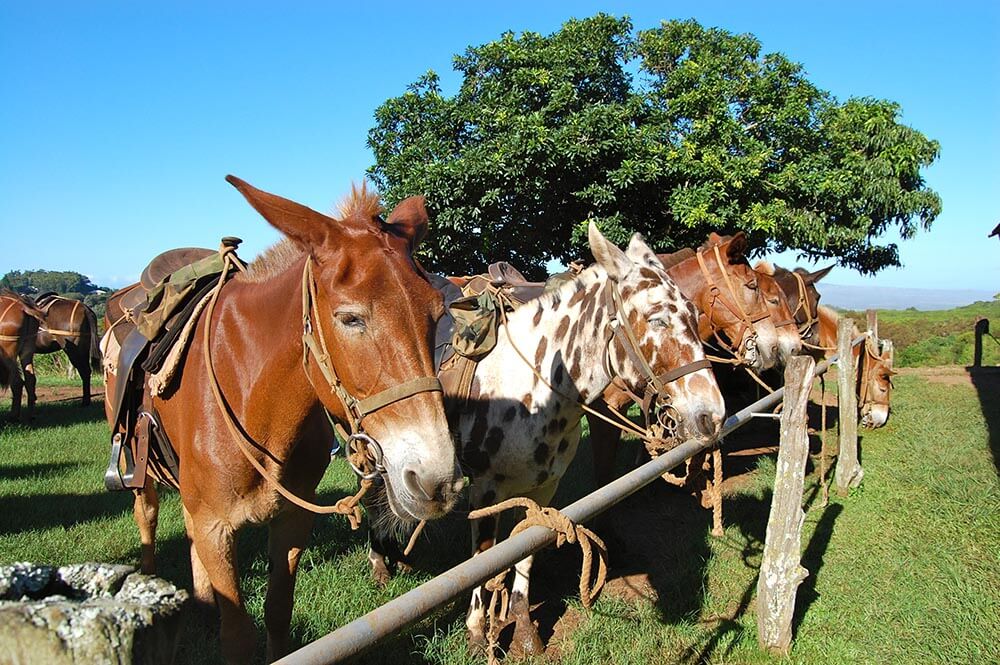
Other Things to do in Molokai Island
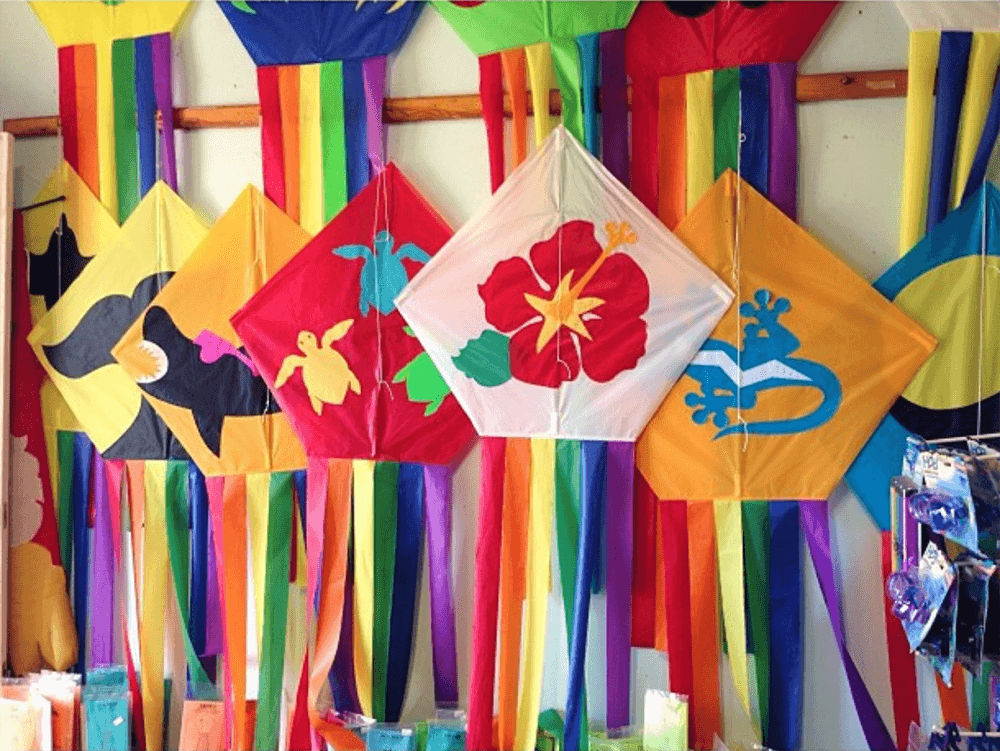
Visiting the Kalaupapa leper colony is a great Molokai day trip from Oahu, but there are also other things to do in Molokai that make it worth staying overnight. Visiting Molokai, and especially Kalaupapa, can be very strenuous, so it might be a good idea to stay the night on the island once you are there. There are not very many Molokai resorts, and that’s what makes the island so charming. Discover the top ten things to do in Molokai.
If you’re going to Oahu, be sure to check out 15 Amazing Things to do in Oahu .
And if you’re heading to Maui, be sure to check out 15 Amazing Things to do in Maui .
If you’re going to Maui, be sure to check out this amazing Guide to Maui!
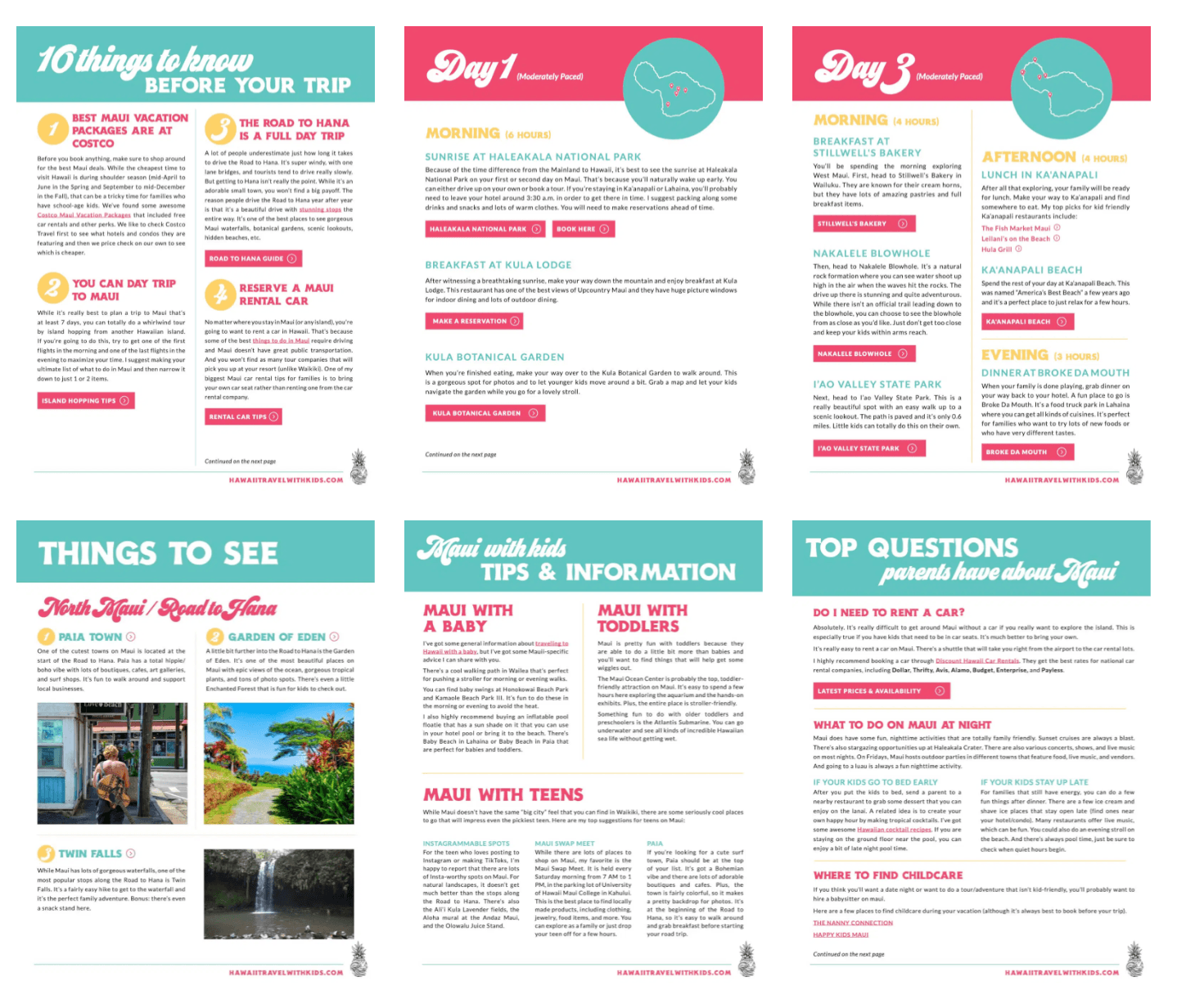
There are so many things to do in Hawaii , I hope this one makes your list!
This was one of the most memorable travel experiences of my life. I hope you get the opportunity to go in your lifetime. Please let me know if you have any questions or need help planning your trip to Molokai. You can connect with me via Instagram or Facebook .
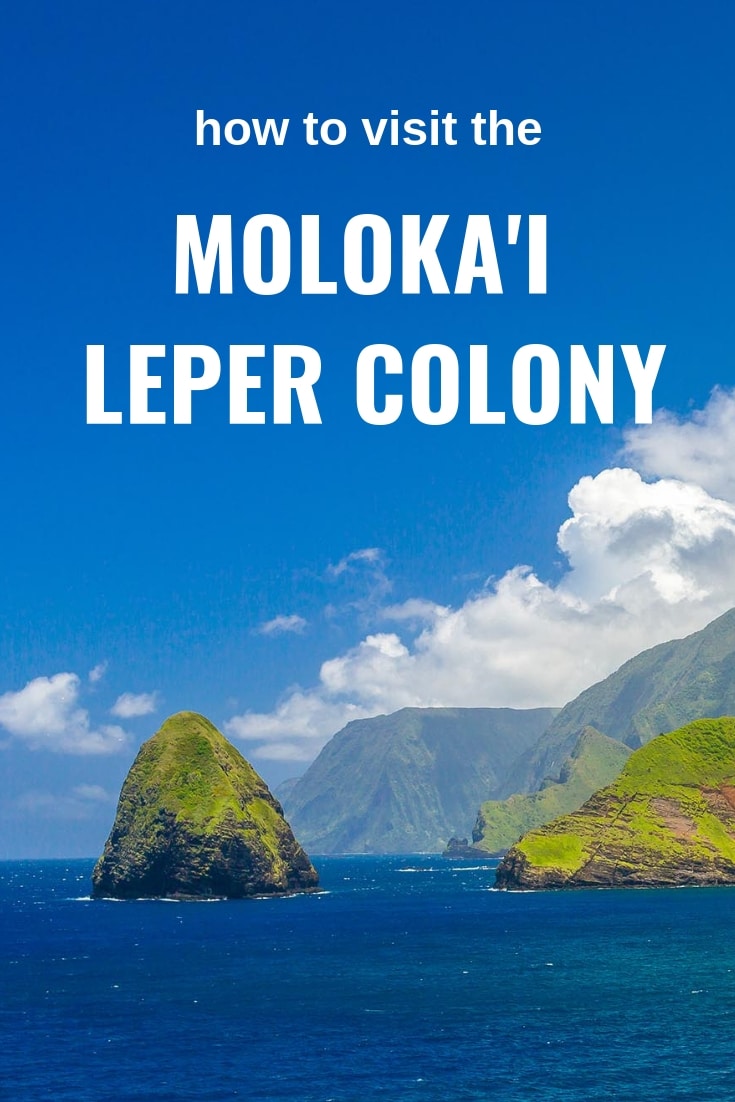
Wanderlust Crew
6 thoughts on “ how to visit the molokai leper colony – kalaupapa hawaii ”.
Pingback: 12 Things to do in Maui with Kids - Wandertoes
correction: The disease spread so fast and grew so much because Hawaiians did not want to part with their beloved. They wanted to care for them at home. Despite the growing numbers and the contagious nature of this disease, these lovely Hawaiians never removed their loved ones from their families or homes. This testament of their loving and familial heritage is why the numbers were so high. The government instituted rules and tried less extreme ways of trying to reduce the spread and deaths but the Hawaiians would not stop caring or loving on their afflicted. Thus, the government in an effort to keep the population, now dwindling, from becoming decimated forcefully removed the ill. And took them to Molokai. And Father Damien did go and was disease free for decades while there on God’s errand until he also finally succumbed to the disease. The town of Molokai was a horrible place to live. The people who lived in it were living a bad life. They had so little to live for, without their loved ones, lost hope, sick, so sick they could not do for themselves as each would eventually become, the longer they lived. They could barely plant, many just went to the tavern and drank themselves into stupors. The living was sordid by those who felt there was nothing left to do. Many were out to get as much pleasure as they could before they would end as those they had seen demise before them. They barely had strength to bury their dead. It was horrific. This is what I learned from reading but I have never been there.
Pingback: Complete Guide to Maui with Kids (Resorts, Beaches, Activities + More!)
One of my Mom’s dreams was to visit the leper colony. Unfortunately she came down with terminal pancreatic cancer and never got the chance. She did win a trip to Oahu so she and I visited the beautiful island and had a wonderful time, went by way to quick but the memories will last me forever. One day God willing I will do a pilgrimage and visit the colony. Steve
I’m so sorry for your loss and I’m glad you were able to spend that special time with her on the island. One day you’ll make it to Kalaupapa and it will be incredible. xo
Pingback: The ULTIMATE 2021 Hawaii Bucket List: 23 Amazing Things to Do! - Explore Now Or Never
Leave a Reply Cancel reply
Your email address will not be published. Required fields are marked *
Notify me of follow-up comments by email.
Notify me of new posts by email.
This site uses Akismet to reduce spam. Learn how your comment data is processed .

Molokai Leper Colony Tour: Adventure, History, and a Mule Ride
July 21, 2023 8 Comments »
Home » Blog » Destinations » North America » America » Hawaii - Molokai » Molokai Leper Colony Tour: Adventure, History, and a Mule Ride
June 18, 2015 8 Comments »
Even though the story is tragic, a Molokai leper colony tour is one of the best things to do on the island. Embark on this deeply moving journey through history is a little tricky. So, here’s all my tips for exactly how to do it.
I listened in shock to our guide Pat as he told the story of Olivia.
“Olivia arrived in the 1930’s. She was 18, engaged to be married, and had been living in Oahu. She went to the doctor to get her tonsils out and was diagnosed with leprosy, but she wasn’t told and was allowed to go home instead. The doctor reported it to the authorities (as required by law) and they showed up at her door to tell her the news and to pick her up to take her to Kalaupapa.
She said that her life ended at that moment. She went to the bathroom to kill herself with Lysol, but didn’t succeed. In the end, she lived exiled in Kalaupapa until she was 90 years old.”
You can find it all over the world, tourism based on tragedy and human suffering. It’s the Killing Fields in Cambodia , Dachau in Germany, Hurricane Katrina in New Orleans , and the 9/11 Tribute Center that recently opened. Something draws us to these sites when we travel.
Table of Contents
Why do we engage in tragic tourism Where is Kalaupapa National Historical Park Getting to the Molokai Leper Colony How to get to Kalaupapa Colony today Permit required to visit Going to Kalaupapa by mule Kalaupapa Father Damien Tour Residents stayed even after a cure was found Things to know before you go to Kalaupapa Books about Molokai’s Leper Colony
Why Do We Engage in Tragic Tourism?
“some have a personal connection to the tragedy as survivors, relatives of victims or witnesses. Others have an intellectual or cultural interest — to understand what happened, or connect the tragedy to other historical events. Others have no connection to the site or the event, but happen to be there as tourists and visit those places as part of their sightseeing.” – Independent Traveler
As I arrived at the Molokai Mule Ride office to take the Father Damien tour, I definitely was the latter. I had heard about the Molokai leper colony, but knew nothing about its tragic history. I was intrigued to learn more, but first we had to get there and that’s not easy.
Where is Kalaupapa National Historical Park?
Kalaupapa National Historical Park , managed by the National Park Service, is situated in the isolated Kalaupapa Peninsula on the north shore of Molokai, at the bottom of the steepest sea cliffs in the world. It’s a hard-to-get-to place that happens to be the most beautiful area of the island. Probably the most beautiful area in all of Hawaii.
May 2023 UPDATE: According to the National Park Service, Kalaupapa settlement and trail are closed to the general public and commercial tours until further notice. A suggested alternative is to view Kalaupapa Peninsula from an overlook at Pālāʻau State Park .

Getting to the Molokai Leper Colony
In 1865, the only way to the Kalaupapa leper colony was by ship – and it wasn’t a pleasant ride.
After being diagnosed, patients were torn from their lives and taken by boat in a cattle pen to a small rowboat that admitted you onto Kalaupapa. This plot of remote land is where most of the patients came to live out their lives and most likely perish. At that time there were no cures for leprosy (now the politically correct term is Hansen’s Disease), and by order of the King the law was to exile all people diagnosed with leprosy to Kalaupapa.
It was so remote and off limits that supplies only came one time per year on a barge, the rest of the time the people fended for themselves.
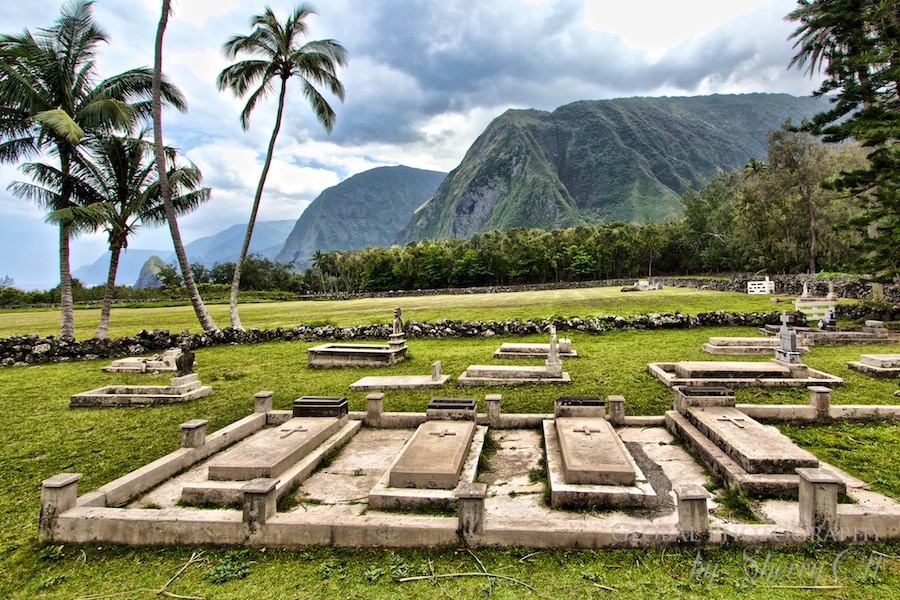
How to Get to Molokai Kalaupapa Colony Today
In 2020, Kalaupapa is still difficult to get to! As part of the Father Damien Tour, you’ve got options.
- Plane – you can arrive by (a very small) plane from Oahu, Maui, or topside Molokai.
- Hike a very challenging, muddy switchback trail down the steepest sea cliffs in the world. The trail traverses a 1,700 foot elevation change over 3.5 miles. And remember – if you choose to hike down the trail, that means you have to come back up the trail – and that is very strenuous.
- Take a mule ride down/up the sea cliffs. Unfortunately, this unique way of traveling the Kalaupapa Trail is suspended indefinitely after the company experienced some unexpected hardships. I will keep an eye on this situation and make updates here with any news.
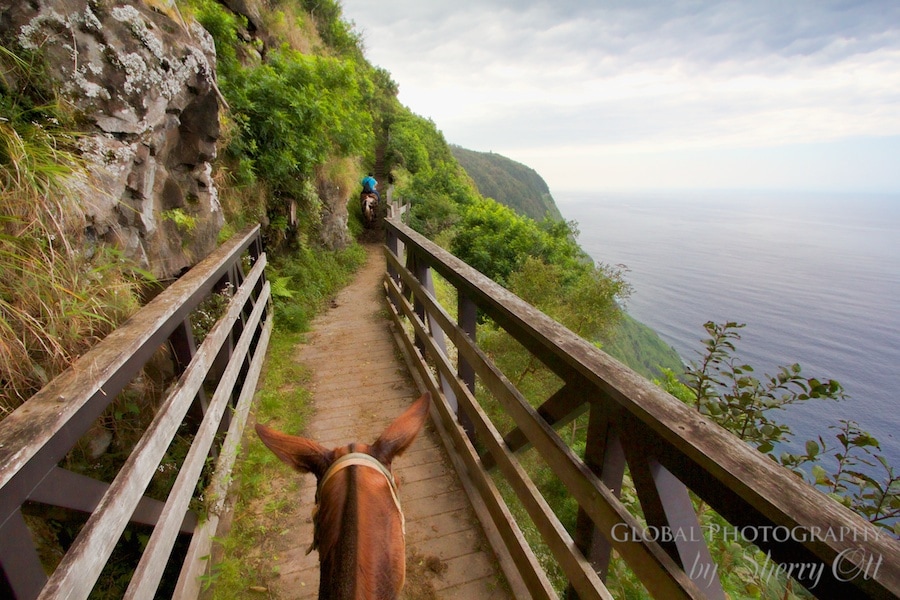
Permit Required to Visit
If you visit Kalaupapa, you must have a permit for visiting. You can do this by booking with the tour company. You can only visit with a guided tour run by Damien Tours LLC. They will take you around the area in an old school bus while teaching you about the tragic past of leprosy and the colony.
If you book a mule trip down the trail, it includes the Father Damien tour and permit.
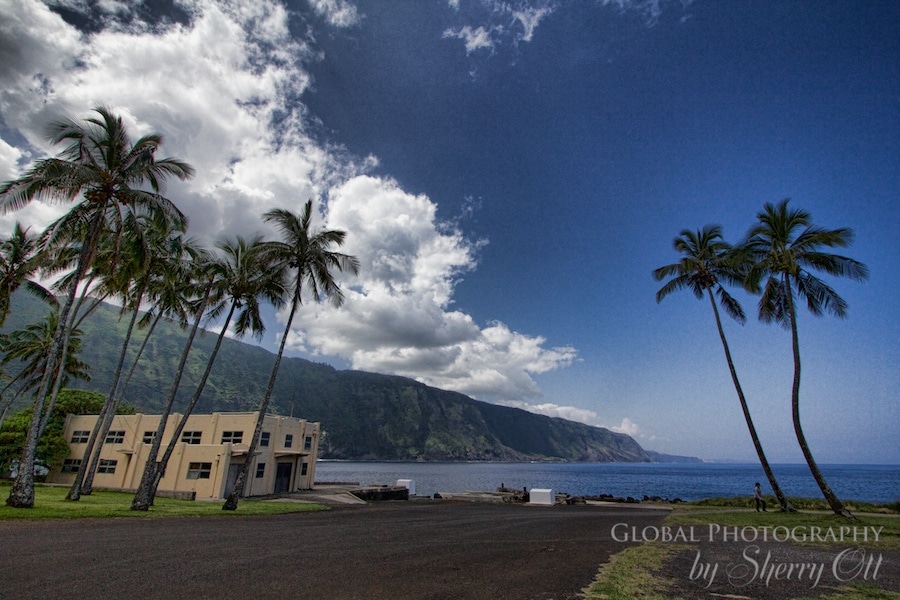
Going to Kalaupapa by Mule
Even though the mule rides are currently unavailable, here is a description of my experience when they were still running.
The trail down the sea cliffs to the Molokai leper colony was created in 1988 and is maintained by the National Parks. When I went in 2015, I chose to take the mules because I heard about the exciting (sometimes harrowing) experience of riding the mules down 1700 feet and 26 narrow switchbacks. Evidently these are the steepest sea cliffs in the world.
By doing the adventurous mule ride, the whole tragic tour seemed ‘lightened up’ a bit. Somehow, they combined adventure travel with a historic tour. This sort of made it more digestible.
Our guides, Audrey and Lulu, answered questions and doled out trivia-worthy facts all the way down the cliffs, which took two hours to get down. The hardest part was holding on and not panicking around the narrow turns. Audrey made a point to tell us that the mules had done this hundreds of times and knew their job and the trail well. She even said that they step in the same place every day.
My favorite thing about the mule ride was seeing how much our guides absolutely loved their jobs. They even got a little teary eyed when they talked about their founder and we all said our final goodbyes at the end.
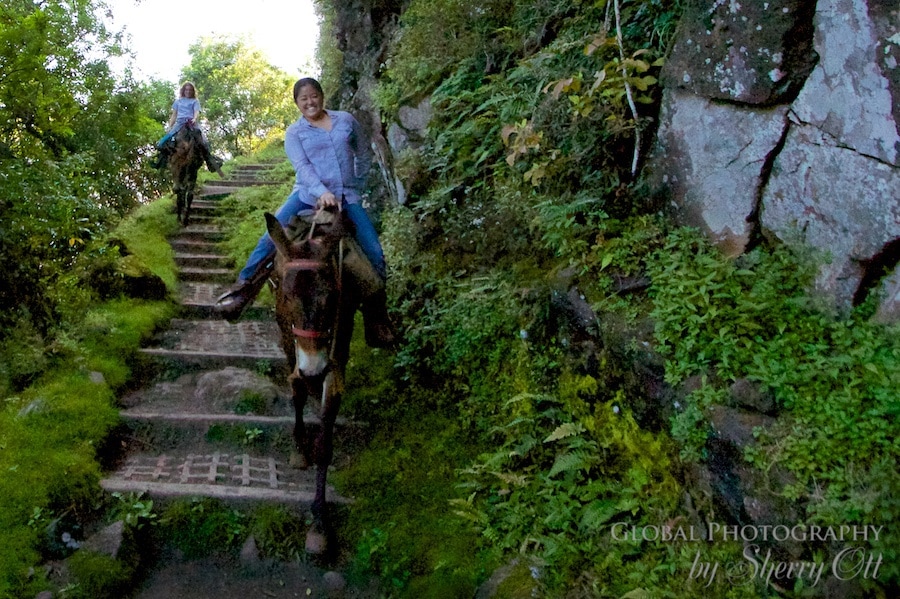
My Mule, Koa
I was put on the mule named Koa, meaning strong warrior. However, he was pretty chill, and had no need to be the lead mule. So, we were pretty happy being second in the procession.
As it turns out, Koa was older and getting ready for retirement. I think that’s why we got along so well.
Much to my dismay, Koa enjoyed swinging really wide in the switchbacks but I trusted him completely. The way up the cliffs was a quicker ride, only 90 minutes. However, it was much harder on the mules. As we stopped and rested at the halfway point, I could feel Koa’s heartbeat as he rested at turn . These were impressive animals.
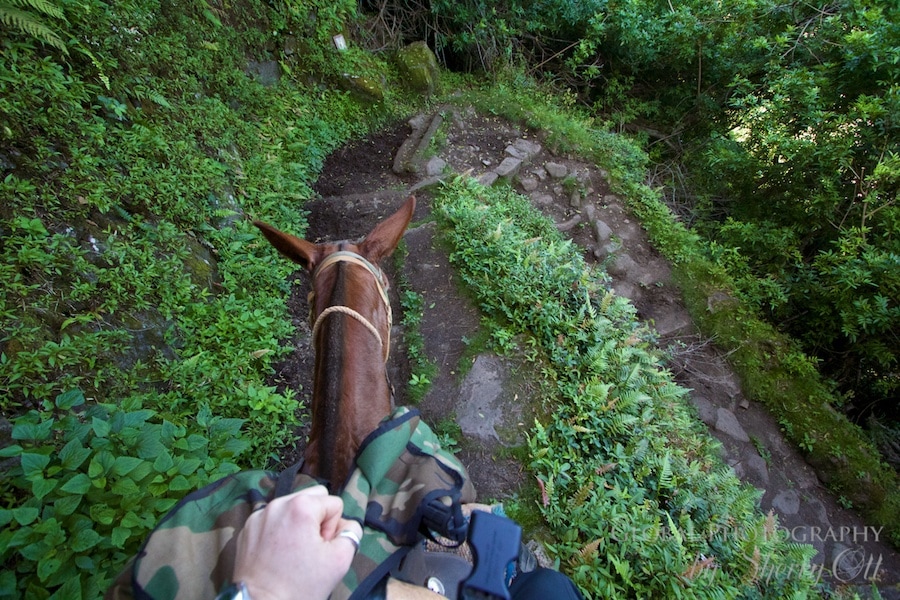
Kalaupapa Father Damien Tour
“It isn’t all tragedy and disaster here,” our guide Pat said, “life did go on; they were a community.”
We met Pat at the bottom of the cliffs and all boarded an old rusty yellow school bus. Others who had arrived by plane or by foot joined us; we were given a sack lunch, and immediately swept into the tragic and touching world of Hansen’s disease all with a gorgeous Hawaiian backdrop.
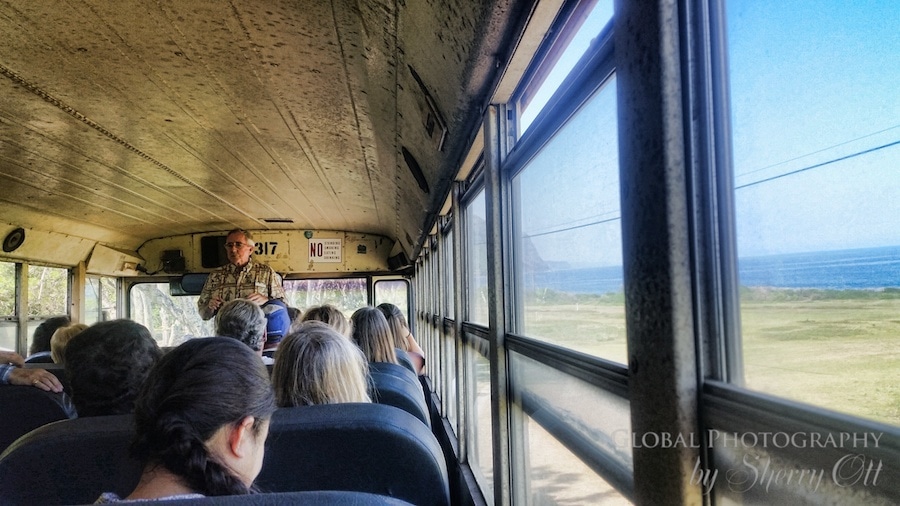
Out of the 8,000 people sent to Kalaupapa throughout the years; 90% were Hawaiian. The Hawaiians were more prone to catching western diseases, as they couldn’t fight off these new illnesses that had been introduced to their culture.
After years of public purgatory, a mixture of antibiotics created in the 1940’s was found as the cure, and after that there was no more real need to isolate. But it wasn’t until 1969 that the laws finally changed in Hawaii and people were free to leave Kalaupapa leper colony. The problem was that many had nowhere to go as the knowledge and stigma about the disease was slow to reach the public and sadly few had any place to go even when they could.
However, as Pat said, they had built a community in Kalaupapa, it was their home now. It had a hospital (however it burned down when they couldn’t start the fire truck), many churches, homes, recreation fields, a gas station that had 5 tanks holding up to 30,000 gallons. And there was even one bar in the community.
Residents Stayed Even After a Cure Was Found
After 1969 many patients stayed, living out their lives there. Not because they had to, but because they wanted to.
Presently, the only people allowed to stay in Kalaupapa are the old patients and the park rangers. Accordingly, sixteen people are still on the list to stay but all are quite old – the youngest is 73 and the oldest 90.
For that reason, in 1980 President Carter created the Historical Park to preserve the Kalaupapa history. and the highly sought after land from being developed.
Pat spent 2+ hours educating us on Hansen’s disease, telling us stories about the people in the community, helping us understand how the community ran. He took us to the many churches and cemeteries in the park and gave us time to reflect upon what we saw.
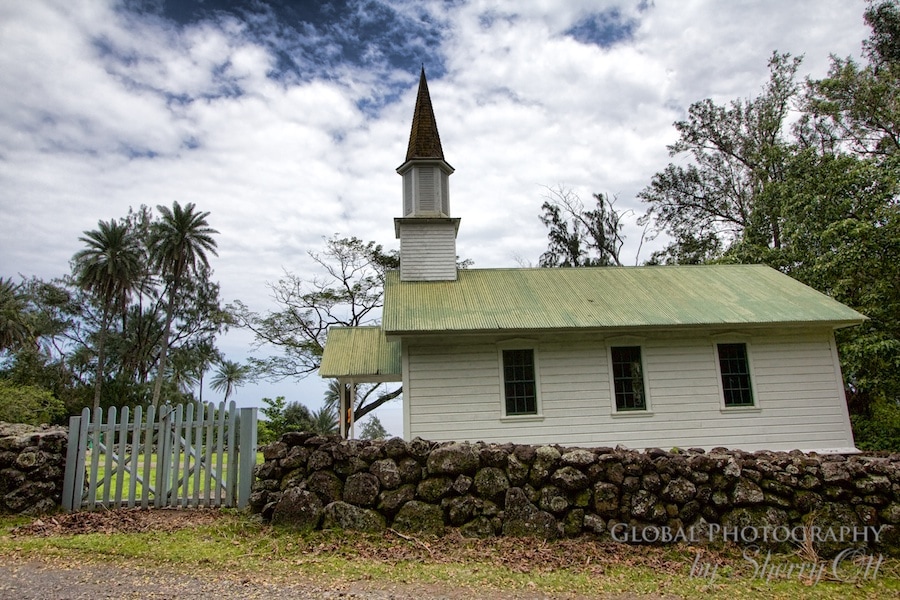
He told us the stories of Father Damien, the heroic Belgium Priest who loved and served this colony of outcasts. Eventually, he caught the disease and perished there at 49 years old.
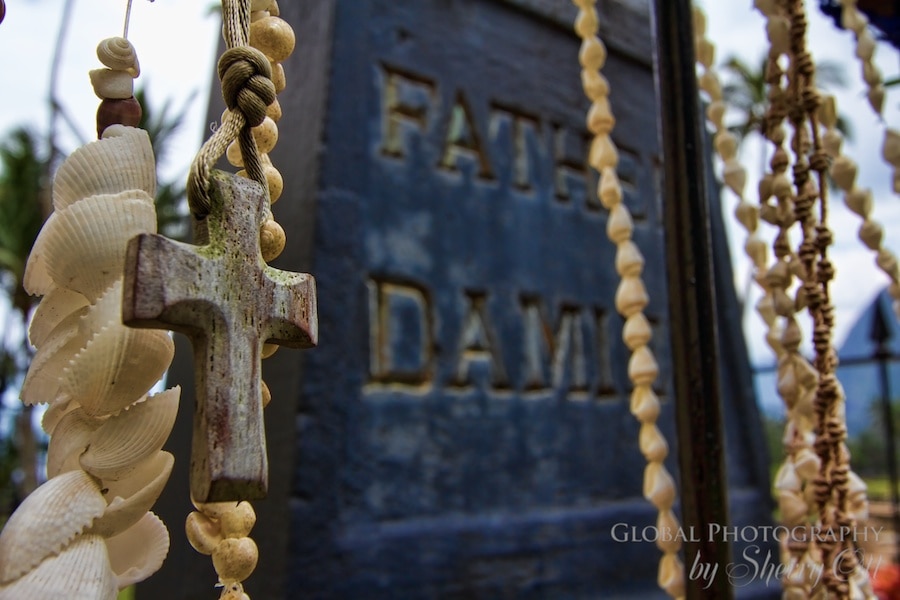
Final Thoughts
The bus returned me back to Koa and we began the ride up the cliffs. While bobbing and swaying up the switchbacks, I had plenty of time to think about what I saw and learned. Overall, the day was a strange mix of sobering, uplifting, and educational.
People engage in tragic tourism for different reasons, but for me it reminds me of how far we’ve come. And it makes me wonder what things our society are doing now that we will look back in 50 years and think are ludicrous. Only time will tell. I also wonder about Koa, what will happen when he retires? Will he miss this trek that he does day after day after day? I think he will.
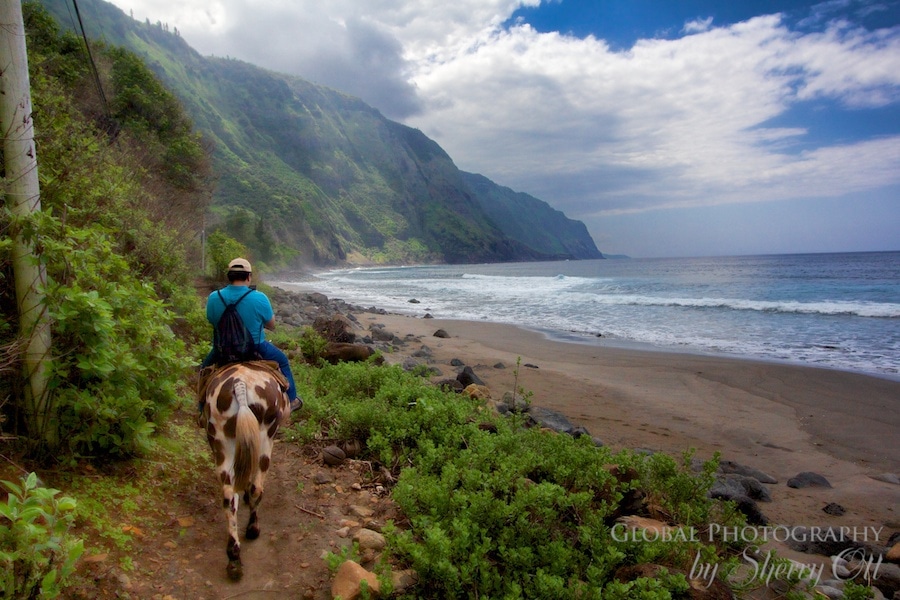
Things to Know Before You Go to Kalaupapa
- You must have a permit in advance to enter Kalaupapa
- You must be 16 years or older to visit
- There are no medical facilities
- There is no food or shopping in the colony – bring your own lunch and water
- Pack out your own trash
- Photography of residents is strictly prohibited. Make sure you talk to your tour guide to know what you are able to take pictures of
- You cannot stay overnight
- Finally, you must be in good physical condition to visit due to the strenuous nature of the trip
Books about Molokai’s Leper Colony
View all kalaupapa pictures.
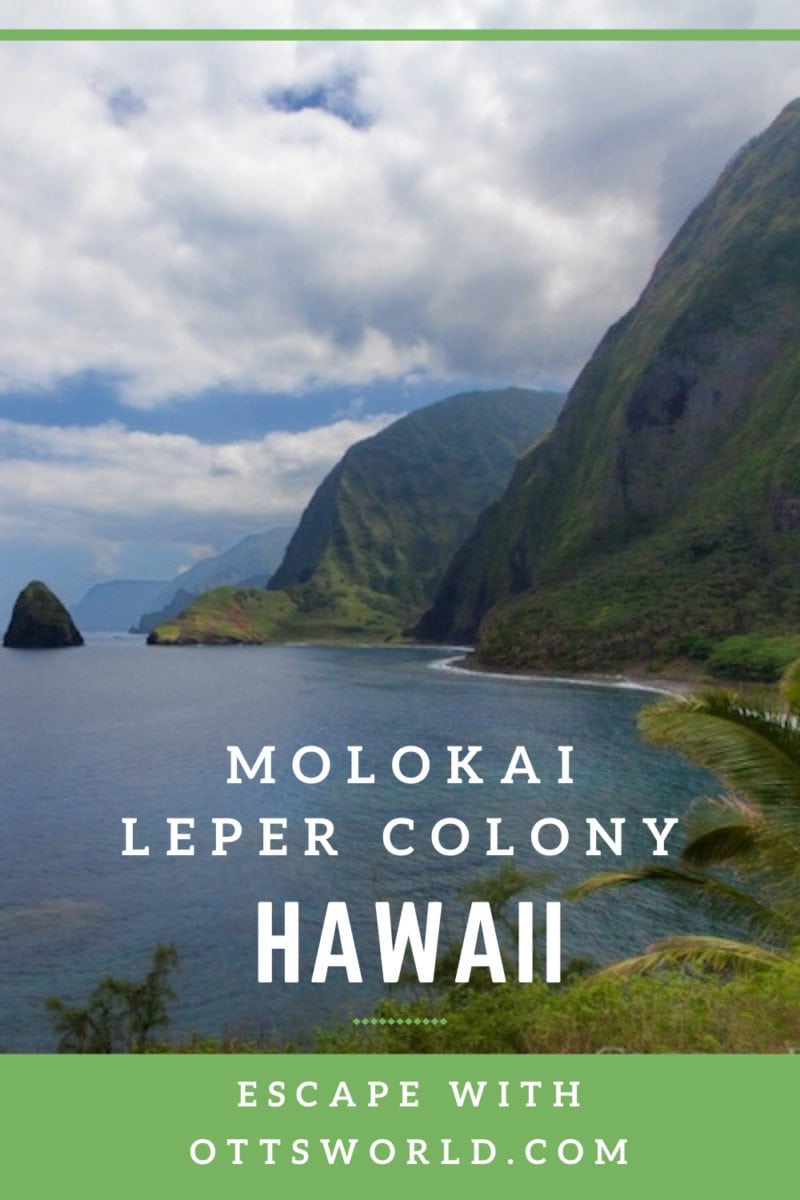
Disclosure:
I was a guest of Visit Molokai during my time on the island, however all opinions here are my own.
This post contains some affiliate links. If you choose to purchase items through these links, I will earn a small commission at no extra cost to you. These commissions help reduce the costs of running this site
8 Responses to "Molokai Leper Colony Tour: Adventure, History, and a Mule Ride"
By Mary @ Green Global Travel June 19, 2015 - 3:15 pm
Wow, what a fascinating trip. Tragic tourism is an interesting field of tourism – informative but emotional at the same time. Thanks for sharing your experience.
By Travis Longmore June 19, 2015 - 9:16 pm
That’s incredible! I’ve never even heard of that place and interesting to call it tragic tourism. I’d never heard of that phrase either but it’s intriguing to think about. Awesome post!
By Sherry June 22, 2015 - 10:47 am
Travis – I hope you make it there one day – it’s a fascinating place and a great Hawaiian island to visit!
By Keliʻi Brown June 22, 2015 - 3:53 pm
Aloha Sherry. This is truly one of the best Kalaupapa stories I have read (and there have been many).
The term “tragic tourism” is certainly apt and I appreciated the link to the Independent Traveler piece.
Mahalo nui!
By Sherry June 22, 2015 - 4:12 pm
Thanks Keli’i! Great to hear from you! I adored Molokai and my time there – so many new things I learned about Hawaii on that trip! Hope you are well! Mahalo!
By Maartin June 23, 2015 - 5:52 am
Great trip, and I liked the pictures. The are amazing! Great job!
By Jade December 28, 2015 - 6:13 am
This is so interesting! I find this stuff fascinating and will definitely have to visit some day.
By Robin December 1, 2018 - 11:36 am
Thank you for all the wonderful photos and information. I am doing research in preparation for leading a county-wide book club discussion on Moloka’i by Alan Brennert. The book is beautifully written from the point of view of a resident who arrived in the 1880’s and allowed to leave in the 1940’s.
These photos will add another dimension to our discussion.
Leave a Reply Cancel reply
Your email address will not be published. Required fields are marked *
* Your Name
* Your Email
Save my name, email, and website in this browser for the next time I comment.
Notify me of follow-up comments by email.
Notify me of new posts by email.
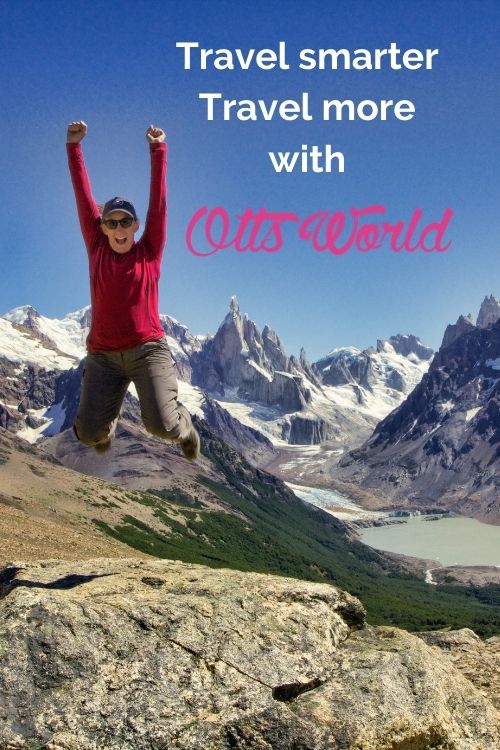
Get my best travel tips,
Unique destination ideas,, and travel discounts, in my weekly email.
Never see this message again.
clock This article was published more than 6 years ago
The site of an 1860s leper colony on Molokai island draws determined travelers
My old mule Tita clopped straight up to the edge of the first switchback. One more step and we’d tumble down a sheer cliff, falling almost 1,600 feet to the sea. But mules are smart creatures and, at the last instant, she swiveled 120 degrees onto the next leg of the pali trail, a rugged path that zigzags down 26 switchbacks to the historic leper colony of Kalaupapa.
The isolated site is the No. 1 tourist destination on the untouristy Hawaiian island of Molokai.
I felt a little queasy on that first switchback, leaning back in the saddle, bracing in my stirrups against the pitch, thinking, “Whoa, that’s a long way down.” Luckily, bushes blocked some of the most vertigo-inducing views, and I had a mule skinner behind me strumming his ukulele and singing in that sweet Hawaiian male soprano that calms the rawest of nerves.
I gave in to the music, the moment, and the instincts of my sure-footed mount.
She was an ornery mule. “Tita” is Hawaiian for “sister,” and this old sister had attitude, stopping willy-nilly, tailgating shamelessly, and working the scary outside edge of the trail, even on hairpins. But I knew she knew her stuff. So, after that first turn, I put my reins around the saddle horn — guides call this “autopilot” — and let Tita make the calls as we plodded downhill in jerks and jolts.
Kayak the Alaskan glaciers of Blackstone Bay while they’re still here
The thumblike promontory taking shape below us — formed of flowing lava, hammered by rough seas and swept by trade winds — became the site of Hawaii’s famed leper colony that was started in the 1860s, almost eight decades before an antibiotic treatment was found to arrest the disease. It was a perfect place for banishment, segregated from the rest of the island by some of the tallest sea cliffs in the world.
Over the years, more than 8,000 exiles would die there, many disfigured, crippled and blinded by the sickness now commonly called Hansen’s disease. At its peak, the settlement had more than 1,200 residents: men, women and children. Today, only a handful remain, all in their late 70s to 90s, along with the dozens of federal and state workers who manage what is now designated the Kalaupapa National Historical Park.
Only 100 outside visitors are allowed into the park each day. They must have permits and cannot talk to the former patients, take their photos or enter their properties. No one under age 16 is allowed.
Visitors to Kalaupapa arrive by one of three ways: They take a small plane, ride the mules, or hike the pali (cliff) trail, an arduous trek for the very fit. The three-plus-mile trail is slippery in rainy conditions, is subject to rockfalls and landslides, and narrows to a few feet in some spots. National Park Service workers occasionally pluck exhausted or injured hikers off the trail, calling for mule rescue or rolling the afflicted down the hill on a special wheeled gurney to be flown to outside islands for medical care.
Mule trips pose their own risks. Riders can fall, or — if they shriek, freak or try to micromanage these heavily muscled, independent animals — can be pitched off. Which is why operators at the long-standing Kalaupapa Mule Ride take tourists’ insurance information, require them to sign waivers and stick to hard rules. It’s okay if you don’t have equestrian experience — guides will explain what to do — but you can’t be over 250 pounds or be pregnant, and you must be in good health.
I would add one more caveat: If you can’t trust an animal, don’t go.
All three ways of getting to Kalaupapa are expensive, requiring permits and prearranged tours on-site. The total for my mule trip, with taxes and fees, was $230. It was pricey, but I had to go. Locals had told me Kalaupapa was a “must-do,” a sacred place with a “special feel.” Every time I pressed for details, there were no more words. “Go. You’ll see for yourself. You’ll know.”
To prepare, I read interviews with longtime residents in the book " The Separating Sickness ." They told tales of being tracked down at home by bounty hunters who got $10 for each suspected leprosy victim reported to the Board of Health. As young children, many were yanked from school, screened and quickly sent to Kalaupapa still crying for their mothers.
No Crowds? No Rush? In Mexico, No Problemo
Many subjects told how they were shunned by old friends and relatives after being diagnosed and sent off to Kalaupapa. "My family hookai [rejected] me. They were sad and disappointed in me for getting this sickness." But there were also spouses and family members who demanded to come with their loved ones, regardless of risk. These were the kokua , the helpers.
I also read up on Father Damien, canonized as a saint in 2009 for his work at the colony. The hearty, handy 33-year-old Catholic priest came to the promontory’s first settlement in 1873 determined to improve the lives of the sick and save their souls for Christ, constructing for them sturdy buildings and, sometimes daily, helping build their coffins and dig their graves.
Only a small percentage of humans are susceptible to the disease, but Damien was one of them. He died in 1889, nearly blind and covered in the festering lesions that had so repelled him when he first arrived. Don’t touch the patients, he’d been told. Within months, he was eating from the same bowl with them, sharing pipes, dressing their ulcerating sores and holding communion wafers to their tongues.
I thought about all these stories as our 11-mule train neared trail’s bottom. My thighs were burning and my knees were stiff and numb as I dismounted, took in the dreamy sandy-white beach beside me, and looked up, stunned by the intimidating green cliff we’d just come down — and would be going back up. “Your joints get a workout on the way down the trail. Can you guess what’s going to get a workout on the way up?” asked our tour guide, Norman Soares. He wore a T-shirt with the image of an open Bible and the words “When all else fails . . . read the instructions.”
Before boarding the tour bus, I asked Soares about a restriction that puzzled me. Why no one under 16? His sunny face turned somber as he explained how infants born in the colony were taken away from parents immediately after birth for fear of contagion. Residents also grieved for children they’d left behind when they were first forced into quarantine. They needed no reminders. “Some patients are still dealing with that brokenness,” Soares said.
He took us to the village’s little bookstore, stocked with volumes on Kalaupapa and religious souvenirs of Father Damien and Mother Marianne Cope, also sainted for her work helping the afflicted in the early decades. We traveled east across the peninsula to Kalawao, site of the initial leper settlement. Soares pointed to a cone-shaped island offshore and described how early sea captains with boatloads of new patients would anchor there, sometimes telling already frightened passengers to jump overboard and swim for shore in rough seas.
Our last stop was St. Philomena Church, which Father Damien expanded twice to accommodate his growing flock. In front of pews, I saw the floor holes that the priest had cut. Our guide told us how patients with excessive drool would roll up big leaves into a funnel, put the narrow end into the holes, and, often through deformed lips, spit through to the ground as they listened to scripture.
In the church’s graveyard, the priest’s admirers had festooned his fenced plot with leis and necklaces of shell and bead. I looked across the other graves in the cemetery and up, past them, to the towering cliffs knifing down into the sea, some of the peaks 3,000 feet high, furrowed with lush ravines and waterfalls. I thought about how, so visibly walled off from the world, homesick, ill, often shunned and forgotten, these exiles and thousands more buried on Kalaupapa made a life for themselves, creating a community that bonded together, celebrated together, married, buried and mourned together. “In Kalaupapa,” said one resident interviewed in “The Separating Sickness,” “we are all in the same boat; we help one another.”
The mule ride up seemed easier on us, harder on the mules. Tita’s sides were heaving halfway up. I could feel her heavy heartbeat through my thighs. And our Kalaupapa tour guide was right. My bottom was seriously saddle sore by the time we reached “topside” Molokai.
I took my tired body to a masseur the next day, and he used some swift Hawaiian Lomi-Lomi moves to “pull up the bad energy from the sore spots and whoosh it away.” As he whooshed, I thought about another kind of ache, the one I’d experienced the day before in Kalaupapa.
It was a strange sensation: a burning of heart, a tug of throat. I realized that it was that “special feeling” locals had described — a spell cast by a place of so much sorrow, so much compassion, so much courage and such staggering beauty. “Go,” said the locals. “You’ll see for yourself. You’ll know.”
I had. I knew.
Lyke is a writer based in Washington state. Her website is marylynnlyke.com .
More from Travel :
In Nova Scotia, tidal-bore rafting offers a uniquely muddy adventure
Hawaii's Last Refuge
Molokai: A soothing step back into old Hawaii
Where to stay
Hotel Molokai
1300 Kamehameha V Hwy., Kaunakakai
808-553-5347
hotelmolokai.com
Modeled after a traditional Polynesian village, the island’s main hotel is close to Molokai’s small downtown in Kaunakakai. Rates are generally $169-$259.
Where to eat
Kualapuu Cookhouse
102 Farrington Ave., Kualapuu
808-567-9655
bit.ly/KualapuuCookhouse
A locals’ favorite, with yummy casual Hawaiian plates such as teriyaki, stir-fry, lemon chicken, grilled mahi mahi, ribs and stuffed shrimp. Open for breakfast, lunch and dinner most days. Breakfast plates $2-$18, lunch $5-17 and dinner $5-$37. As for the service, “If you’re in a hurry, you’re on the wrong island,” the menu says. Cash only.
Kanemitsu’s Bakery and Coffee Shop
79 Ala Malama St., Kaunakakai
808-553-5855
bit.ly/KanemitsusBakery
A popular island hangout with fresh-baked breads and pastries. Around 7:30 p.m. most weeknights and 7 p.m. weekends, locals head down a small adjoining lane to the bakery’s back door to buy hot loaves of bread ($8-$10.25) filled with strawberry, cinnamon, blueberry, cream cheese and butter flavorings. They are traditionally eaten in one sitting
The Kalaupapa National Historical Park and guided mule tour
Highway 470, Mile Marker 5, Kualapuu
808-567-6088
muleride.com
Make mule-trip reservations well in advance and call close to your expedition: Trips are subject to weather and other conditions affecting trail safety. Cost is $230 per person, including taxes and fees. Fee includes a sandwich lunch, a guided bus tour with Kekaula Tours and permits. If you plan to hike, you can also book that through the mule operators. Cost of hike, with permit, sack lunch and guided bus tour is $87, with taxes and fees, and you must be 16 or older. Make sure you’re in shape for a steep, rugged, six-plus-mile round-trip trek. Take plenty of water and snacks.
Damien Tours
P.O. Box 6, Kalaupapa National Historical Park
808-567-6171
damientoursllc.com
Hikers and fly-ins can book directly with Damien Tours for an immersive tour of Kalaupapa operated by patient-residents inside the village. Cost of the permit and guided van tour is $60, and you must be 16 or older. Bring your own lunch. Cash or check only.
Palaau State Park
Highway 47, Ho’olehua
808-984-8109
bit.ly/PalaauStatePark
If you don’t want to hike, fly or ride the mules into Kalaupapa, you can take this quick stroll on a handicap-accessible path to a well-signed overlook. You’ll gaze down some 1,600 feet onto the promontory selected to be a leper colony in the 1860s. Best to go on a clear day. Nearby, across the parking lot, is the short trail to Molokai’s famous Phallic Rock.
Molokai Museum and Cultural Center
1795 Kalae Hwy, Ho’olehua
808-567-6436
The small museum has a fine collection of photos of the Kalaupapa settlement and its residents over the years. There is also a nicely restored pioneer sugar mill on site. The gift shop has interesting local items. Entry is $5. Open 10 a.m. to 2 p.m., Monday through Saturday.
Information
nps.gov/kala/planyourvisit

- Work With Me

Visiting Kalaupapa: Hawaii’s Leprosy Colony
I recently embarked on what I consider to be one of my most transformative travel experiences to date. I spent just under a week on the Hawaiian island of Molokai, and more importantly, I spent a day touring Kalaupapa, Hawaii’s leprosy colony.
If you follow me on Twitter, you may already know this, as I attempted to disentangle some of my thoughts there initially and share some of my experience at the settlement.
Now that I’ve had some time to digest my visit to Kalaupapa, Hawaii’s leprosy colony on the isolated peninsula on the island on Molokai, I was to share some moments from my time there. pic.twitter.com/wJoej12eqe — Emily De Sousa ✈️🥑 (@airplaneavocado) February 25, 2020
I knew that this was going to be a difficult post to write. It was going to take a while before I drafted something that I felt both appropriately represented the horrors that occurred here, while highlighting its historical significance and honouring the Hawaiian culture.
Writing anything about Molokai has proven to be incredibly difficult. Molokai is a very special island that wants to remain unchanged. The locals there have a saying:
Don’t come to change Molokai, let Molokai change you.
Anybody who writes about Molokai or shares their experience with a wide audience as I am, runs the risk of unintentionally inviting unwanted visitors to the island: visitors who want to change Molokai. But, by keeping my experience on the island to myself, I feel that I am also doing a disservice to those who could benefit from the stories that this magical island has to offer.
At the end of the day, I am a storyteller. It is my job to share these stories, but to do so in a way that is honest, respectful, and sensitive to Hawaii’s culture and Molokai residents. I know that many people may never have the chance to visit Kalaupapa and those who can’t visit themselves should still have the opportunity to understand and appreciate this important piece of Hawaiian history.
I am prefacing all of my Molokai posts with this information to be supportive of Molokai residents’ desire to preserve the island’s culture. Before you continue reading, I ask you to keep this in mind. Do not come to change Molokai.
If you’re ready to open your hearts and minds to the island of Molokai, to understand its important place in Hawaiian culture and honor its rich history, then I hope you enjoy this post, as well as my other stories from Molokai.
This post highlights some of the history of Kalaupapa, Molokai’s leprosy colony, and is a reflection of my thoughts and experiences during my visit.
I have written a “Guide to Molokai” which is a resource for those who are intending to visit the island and want to know more about the logistics of planning a trip there. I have temporarily held off on publishing this guide, due to the evolving COVID-19 pandemic and global travel restrictions. Once things have settled down and we’re on the other side of this, I fully intend to make this resource available to everyone. I hope you understand my rationale for temporarily holding back this content.
History of Exile in Hawaii
Beginning in the 1830’s, leprosy spread rapidly through the native Hawaiian population, causing alarm and panic.
Early myths about the disease associated it with biblical references; it was thought to be a punishment from God for immoral behaviour and sexual promiscuity. People hated and feared those whose bodies were marked by the disease and a result, leprosy patients were, and still often are, stigmatized and shunned by mainstream society.
For years, the disease was long feared to be highly contagious. Leprosy causes skin sores, nerve damage, and muscle weakness—symptoms that become debilitating if left unaddressed but are now treatable with antibiotics.
In response to growing concerns about the spreading of the disease, in 1865, King Kamehameha V signed into law “An Act to Prevent the Spread of Leprosy” which allowed for the exile of all people with leprosy to Kalaupapa, an isolated peninsula on the island of Molokai.
Segregated from the rest of the island by some of the tallest sea cliffs in the world and surrounded by the ocean on the other sides, the isolated peninsula was the perfect place for banishment.
One of the worst things about this illness is what was done to me as a young boy. First, I was sent away from my family. That was hard. I was so sad to go to Kalaupapa. They told me right out that I would die here; that I would never see my family again. I heard them say this phrase, something I will never forget. They said, ‘This is your last place. This is where you are going to stay, and die.’ That’s what they told me. I was a thirteen-year-old kid. Male, part-Hawaiian, c. 1977-78
On January 6, 1866 the first group of, 12 patients, arrived at the settlement for isolation.
11 of them died within the first five years in exile.
Kalawao, on the east side of the peninsula, was the site of the initial leper settlement. The cone-shaped island offshore is where early sea captains with boatloads of new patients would anchor, as rough seas often made it impossible to get any closer to shore. Frightened passengers were then forced to jump overboard and swim for shore in rough seas. Many of them never made it and drowned.
There was little in the way of infrastructure and resources when the first patients arrived. It was believed the patients would be able to support themselves by raising animals, farming, fishing, and living the subsistence lifestyle. What wasn’t accounted for was the effects of the inhospitable cold and damp Kalawao climate, which contributed to the patients’ decline and their inability to participate in any day-to-day tasks.
The early years of the settlement brought chaos, confusion, and conflict. More patients began to arrive but weren’t being given food provisions from the Board of Health. The only food available to new patients was the food shared by existing patients and often food shortages caused disputes among patients. Soon, there also weren’t enough homes in the settlement, causing more conflict among the patients.
As time passed, conditions gradually improved due to patients demanding more respectable living situations and a few key champions advocating the Board of Health on their behalf. Eventually, the settlement was moved from Kalawao to Kalaupapa, where the conditions were more favorable. The patients of Kalaupapa began to form a community of sorts – they planted, rationed food, socialized, fell in love, got married, and had babies.
Almost all women in the settlement gave birth at one point, but due to the fear of contagion, newborns were immediately removed from the care of their mothers and put up for adoption. The Board of Health made all efforts to erase any trace of the child’s true lineage as leprosy stigmas would result in the child not being adopted. Many children born in Kalaupapa grew up never knowing where they came from or who their parents were.
You know, the babies that were born inside here were not allowed to stay with their parents. After the babies were born, the law said they had to be taken away to the baby nursery in Kalaupapa. They were afraid of the contact—afraid the babies would catch the disease from their parents…. But some of my children, I will tell you this, some of them I kept longer. Most times, the babies were born in the night. We kept everyone quiet so the administrators and nurses would not hear the baby being born. All my babies were born in my own home, right here . Male, Hawaiian, c. 1977-78
Alongside the tragedy of Kalaupapa were stories of incredible courage and sacrifice.
In 1873, Father Damien, a 33-year-old Catholic priest arrived in the settlement determined to improve the lives of the sick and save their souls for Christ, constructing sturdy buildings and, sometimes daily, helping build their coffins and dig their graves. From the very first day he arrived, Father Damien broke all the rules of engagement, regularly touching patients and sometimes even eating from the same dishes as them. He never saw them as “lepers” but as friends.
After he contracted leprosy, Father Damien wrote that he was now “the happiest missionary in the world.” He died in the settlement 1889 at the age of 49.
As the population in the settlement grew, there was a growing need for nurses to care for female children, women, the elderly, and the bedridden. Before Father Damien passed, he wrote to over fifty different sisterhoods requesting help in Kalaupapa. Only one answered the call.
Mother Marianne Cope, another beacon of hope for Kalaupapa patients, arrived in the settlement in 1888.
She is credited for strengthening the community in the settlement and working tirelessly to make it a more beautiful place for patients. In addition to looking over all of the women and girls, Mother Marianne raised money to start programs that gave patients a more dignified life. She developed classes to allow young girls to continue their education. She provided religious counseling and tried to beautify the landscape by planting gardens.

Mother Marianne worked in the settlement for 30 years. She died of natural causes in 1918. Neither her nor any of the sisters ever contracted leprosy during their time in the settlement.
Both Father Damien and Mother Marianne were both canonized as saints. Kalaupapa remains the only place in the world where two saints worked and died.
The End of Exile
Over the years, more than 8,000 exiles would die in Kalaupapa, many disfigured, crippled and blinded by the sickness. At its peak, the settlement had more than 1,200 residents: men, women and children.
In 1946, sulfone drugs were introduced for long-term care of leprosy patients. Leprosy should have been less scary since effective treatment made patients no longer contagious. Yet, it wasn’t until 1969, more than 20 years after the treatment had been introduced, that the official isolation policy ended in Hawaii.
104 years after banishment began, the exile law was finally lifted.
Despite this new freedom, the social stigma associated with leprosy continued, and many patients felt shunned by their communities even after their treatments were complete. Despite the new treatment for leprosy, the stigmatization of the disease continued. Those who did leave found it difficult to accomplish basic tasks like get a job and rent an apartment because as soon as people found out you were from Kalaupapa, they didn’t want to be anywhere near you. For many patients, Kalaupapa was the only home they knew after being exiled as young children and spending decades in isolation.
Though they were now free to leave, most have stayed and lived out their days here.
I remained in Kalaupapa for thirty years. I was finally paroled in 1966. My mother was still alive, so I wrote to her and told her I was finally cured. I could come home. After a long while, her letter came. She said, ‘Don’t come home. You stay at Kalaupapa.’ I wrote her back and said I wanted to just visit, to see the place where I was born. Again, she wrote back. This time she said, ‘No, you stay there.’ You see, my mother had many friends and I think she felt shame before them. I was disfigured, even though I was cured. So, she told me, her daughter, ‘Don’t come home.’ She said, ‘You stay right where you are. Stay there, and leave your bones at Kalaupapa. This place is finally my real home. They take good care of me here. Female, Hawaiian, c. 1977-78
Kalaupapa Today
Today, leprosy is better understood, we know that it doesn’t spread easily, and it can be treated with antibiotics.
In 1980, the colony was turned into a National Historical Park, now known as Kalaupapa National Historic Park. Kalaupapa is no longer a prison for those afflicted by leprosy, but now serves as a refuge for the remaining patients of the settlement.
As of February 2020, five patients remain in Kalaupapa; the youngest is 79 and the oldest is 96.
The Hawaii Department of Health administers the site with a group of approximately 75 state and federal workers, including nurses, maintenance people, police, firefighters, and National Park Service employees. Workers live in the settlement five days a week and fly home on the weekends.

The Future of Kalaupapa
The future of Kalaupapa has become a recent discussion in Hawaii. As only five patients remain in the colony, it embarks the question: what will happen when the last patient dies?
The only certainty at this point, is that once the final patient dies, the state will leave, and the National Park Service, who’s intentions with the settlement remain largely undecided, will take over Kalaupapa.
According to a 2015 report, the “preferred” proposal of the National Park Service would fully open Kalaupapa up to tourists. This preferred proposal has caused significant concern among Native Hawaiians and Molokai residents who fear that the days of Kalaupapa as they know it are numbered. This debate is further exacerbating political and cultural tensions in Hawaii, deepening the divide between locals and outsiders to the islands.
The non-profit organization Ka ‘Ohana O Kalaupapa , made up of remaining patients and non-patients with ties to the settlement are fighting tirelessly to make sure authorities “leave Kalaupapa as Kalaupapa”. The organization is dedicated to promoting the value and dignity of every individual exiled to Kalaupapa and hope to serve as a resource for decision-makers to preserve, protect and perpetuate the history, the way of life, the values, the cultural heritage and the environment.
During my visit to the settlement, our tour guide seemed to recognize that change would be inevitable once patients are gone, as many of the laws and restrictions in place in the settlement only exist to protect patients. Once they are gone, there will no longer be a need for them. While our guide believed many of the restrictions would be lifted, he was confident the settlement would remain a protected national park, sheltered from any further development.
While the future of the settlement remains in the limbo, the five remaining patients are safeguarding it for the time being. Once they are gone, there is no doubt in my mind that the spirited people of Molokai and Hawaii will do everything to make sure that this sacred land is protected and those who were exiled are never forgotten.
While the patient population may no longer be with us physically, they will always be present spiritually. They will always be part of this land. Ka ‘Ohana O Kalaupapa
If you are interested in supporting the efforts of Ka ‘Ohana O Kalaupapa, you can DONATE HERE.
Planning Your Visit to Kalaupapa
I won’t go in to too many details about the logistics of how to get to Kalaupapa. Most of this information is available on the National Park website .
Only 100 outside visitors are allowed into the park each day. If you wish to visit, you need to plan well in advance as you’ll need to obtain a permit, which most tourists do by booking directly through a tour company. It is ILLEGAL to enter Kalaupapa without a permit.
As of February 2020, the Kalaupapa Trail remains closed indefinitely due to a landslide, meaning Kalaupapa is only accessible via aircraft at this time.
*UPDATE: Due to the COVID-19 pandemic, the park is currently closed to outside visitors.
Why You Should Visit
One of the main reasons that I travel is to experience other cultures and learn about their history. As a traveler and as a human being, I felt a responsibility to understand this story and share it to keep the memory of those we lost alive.
As someone with a deep, deep love for the Hawaiian Islands, it is heartbreaking that this piece of its history is so hidden from plain sight. Most tourists to the islands will drink their Mai Tai’s on Waikiki Beach, oblivious to the horrors that occurred just 85 kilometres away.
Travel is supposed to open your mind and widen your perspective; in Hawaii, Kalaupapa is the place to do that. If you’re truly looking to learn about and honour Hawaiian culture, then you need to visit Molokai and Kalaupapa.
Further Reading
Through this article, I have aimed to provide a high-level overview of what I think are some of the most important pieces of Kalaupapa’s history, but it by no means represents the entirety of its story.
Whether you plan to visit Kalaupapa or not, I highly recommend take some time to learn more about the history of this sacred place. Reading some of these books are what inspired me to visit Kalaupapa in the first place and having a bit of prior knowledge made my time in Kalaupapa that much more impactful, as I was able to see and experience the places I’d only read about in books and better understand the atrocities of each space.
- The Colony – John Tayman
- Molokai – Alan Brennert
- The Separating Sickness – Ted Gugelyk and Milton Bloombaum
Need a place to stay on Molokai? Check out my review of Hotel Molokai.
- Symbiotic Commemoration: The Stories of Kalaupapa
- National Park Service
- Ka ‘Ohana O Kalaupapa
- In their own words – testimonies of patients exiled to Kalaupapa
- National Park Service Draft Management Plan and Environmental Impact Statement
- Kalaupapa: A Collective Memory
Related Posts
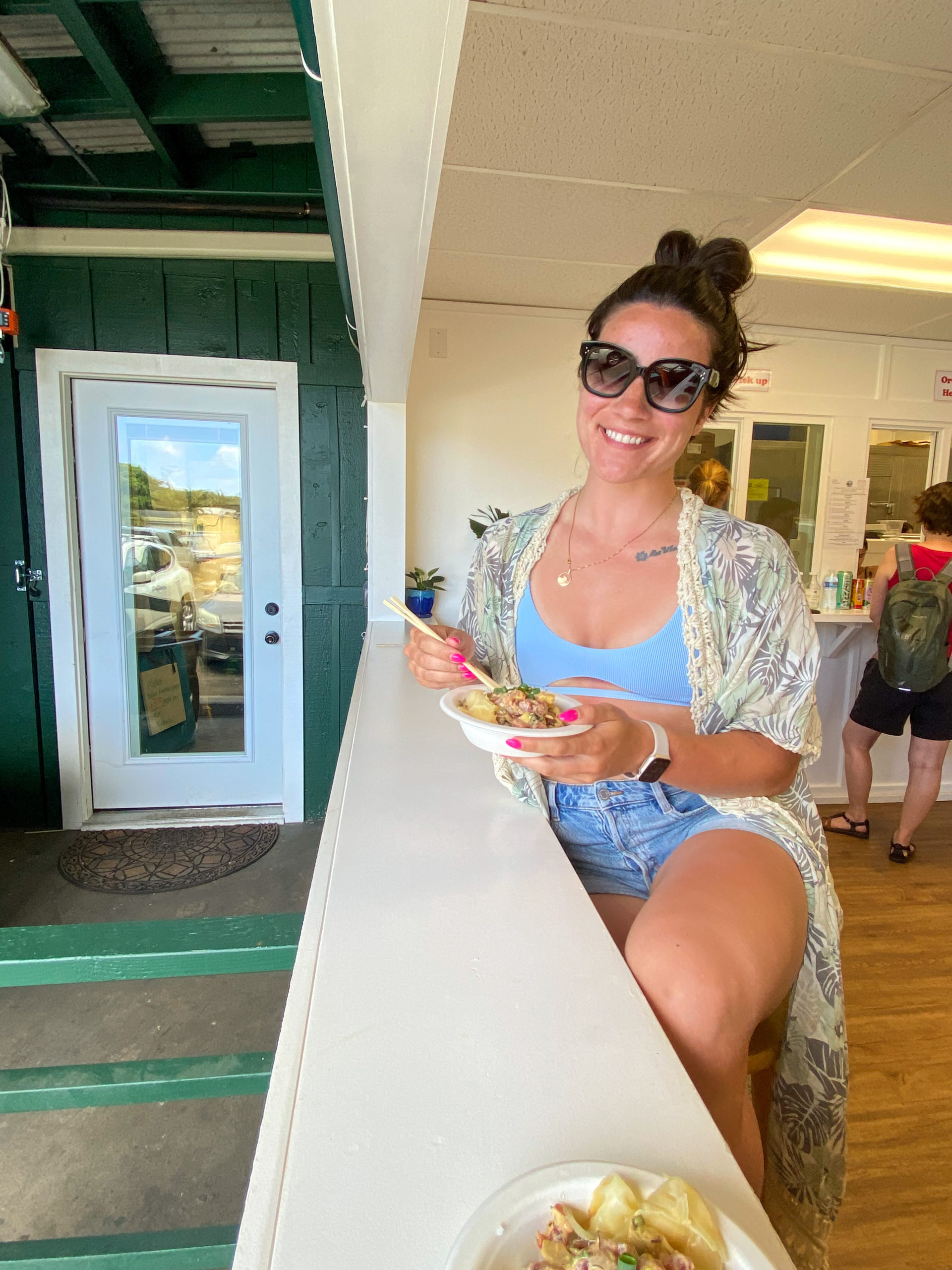
Kauai Seafood Picks
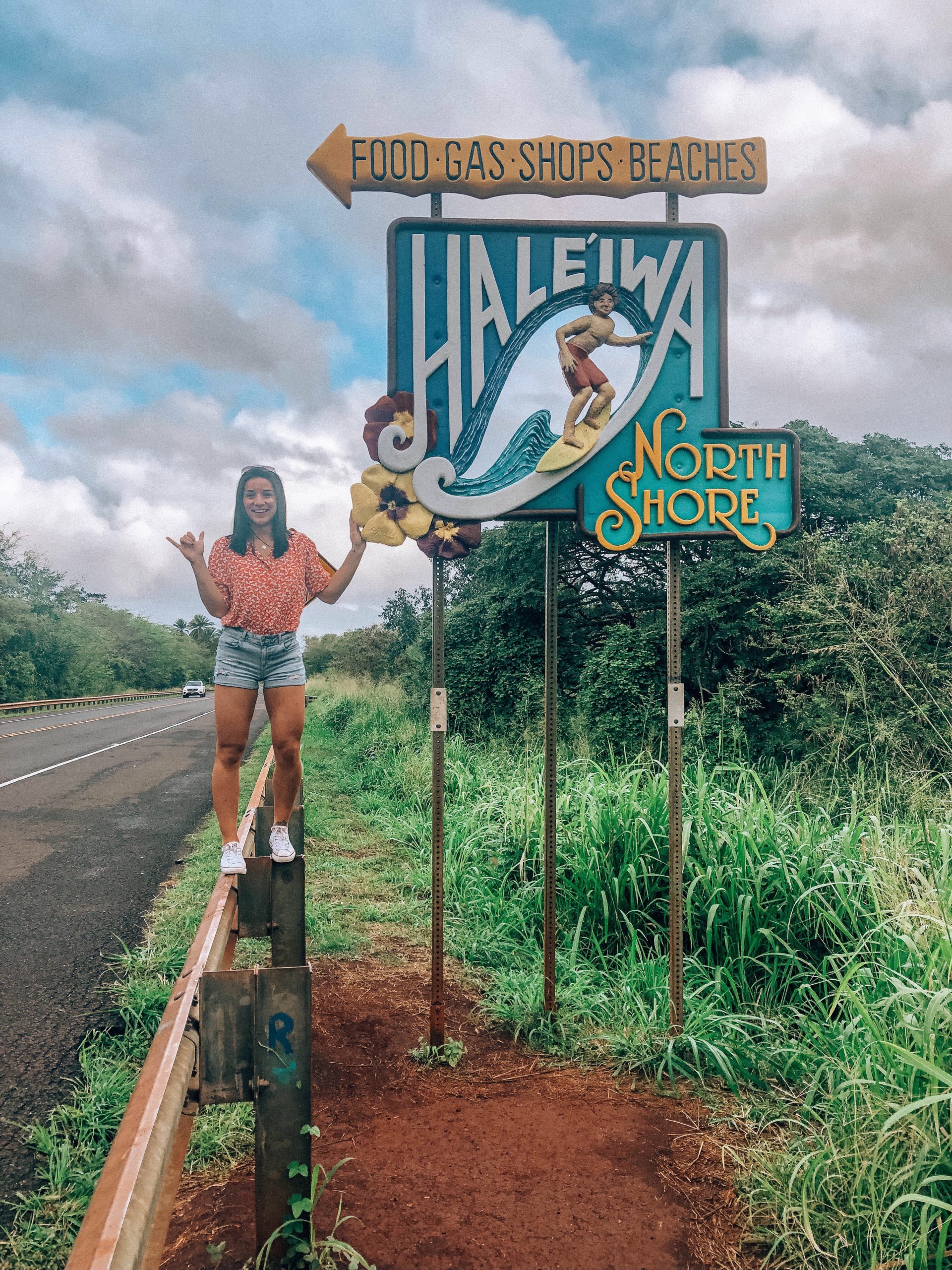
12 Most Instagrammable Places on Oahu
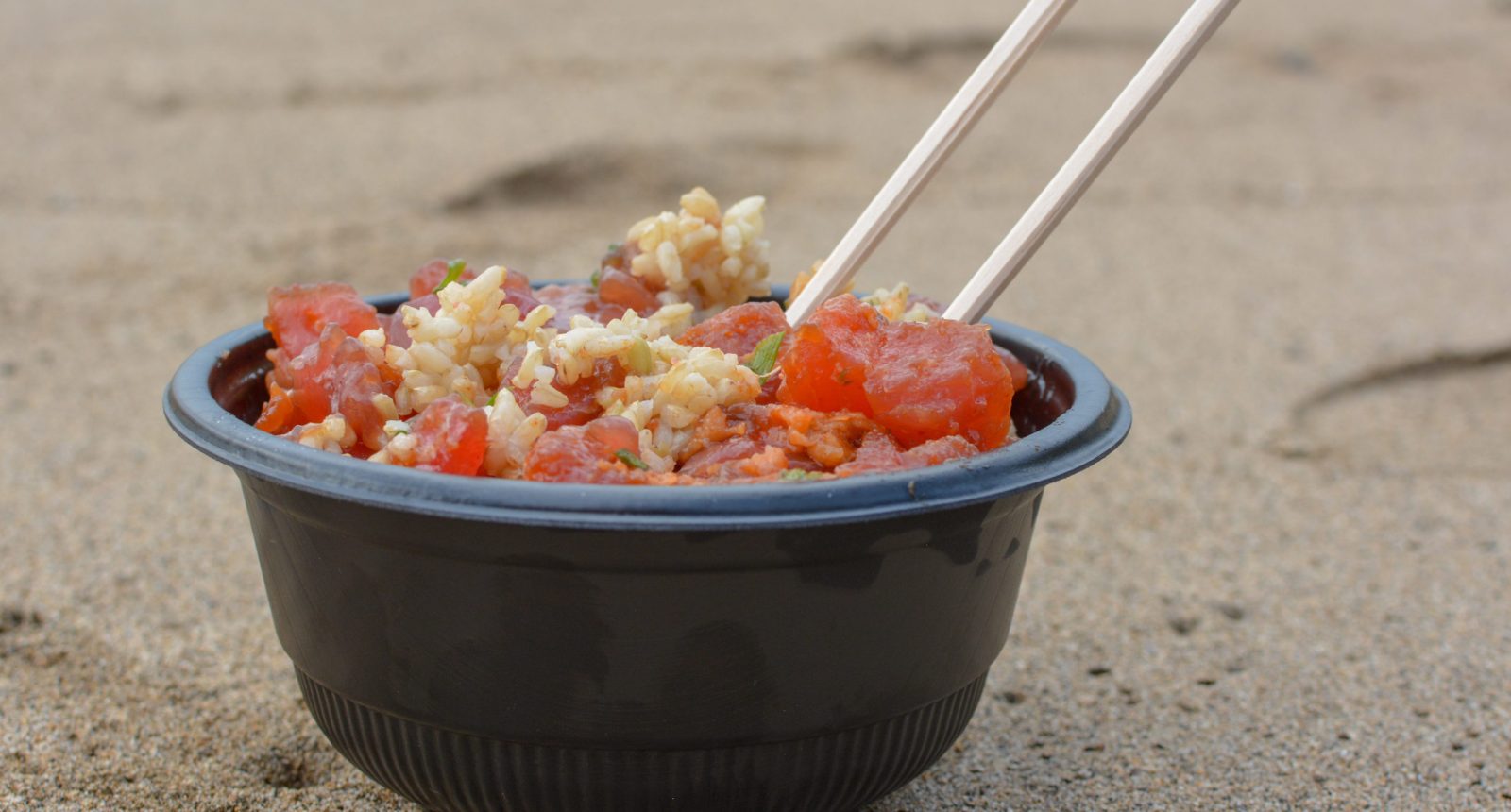
Where to find the best poke on every Hawaiian island
RoadsideAmerica.com Your Online Guide to Offbeat Tourist Attractions
Attraction:
Kalaupapa, Molokai, Hawaii : Mule Ride to a Leper Colony
It takes a full day there and back, but the views are nice.
Kalaupapa National Historical Park.

Visitor Tips and News About Mule Ride to a Leper Colony
Reports and tips from RoadsideAmerica.com visitors and Roadside America mobile tipsters . Some tips may not be verified. Submit your own tip .
While you're on Molokai, you can book a mule ride expedition down to the Kaulapapa Hansen's Disease Leper Colony . The US Park Service conducts tours of the Hansen's facility, including a visit to the church where Belgian priest and hero to the outcasts Father Damien is buried. After helping residents for many years, he died of complications from Hansen's Disease himself. The mule ride takes you down a sheer cliff to the colony, 1664-feet below. Not for timid folks! Call (808) 567-6088 for further information and/or reservations.
Nearby Offbeat Places
Latest Tips Across Roadside America
Catch up on the latest discoveries from the road .
Explore Thousands of Oddball Tourist Attractions!
Unique destinations in the U.S. and Canada are our special obsession. Use our attraction recommendation and maps to plan your next road trip.

Map and Plan Your Own Roadside Adventure ... Try My Sights
Mobile Apps

Hawaii Latest Tips and Stories
- Raelian UFO Peace Park , Volcano, Big Island, Hawaii
- Surfin' Seal , Honolulu, Hawaii
- Shaka Roundabout , Koloa, Kauai, Hawaii
- Lahaina Banyan Courtyard , Lahaina, Maui, Hawaii
- Hawaii's Oldest Surviving Tiki Bar , Honolulu, Oahu, Hawaii
Latest Visitor Tips
Sight of the Week
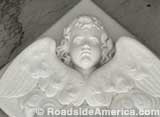
Bloodstained Tomb of Nina Craigmiles , Cleveland, Tennessee (Apr 8-14, 2024)
SotW Archive
USA and Canada Tips and Stories
- Riverboat Motel , Branson, Missouri
- Feature: Bloodstained Tomb of Nina Craigmiles , Cleveland, Tennessee
- Giant Lady's Leg Sundial , Roselawn, Indiana
- Gravesite Rocket Memorial , Stryker, Ohio
- Feature: Roadside Sideshow Expo , Lucas, Kansas
More Sightings
Favorite Quirky City Sights
- Honolulu Attractions

Miscellaneous
- Submit a Tip
- Privacy Policy
- Terms and Conditions
Trip Planning Caution : RoadsideAmerica.com offers maps, directions and attraction details as a convenience, providing all information as is. Attraction status, hours and prices change without notice; call ahead!
Credits, Media/Business Inquiries © Copyright 1996-2024 Doug Kirby, Ken Smith, Mike Wilkins. All rights reserved. No portion of this document may be reproduced, copied or revised without written permission of the authors.
YourIslandRoutes
Portuguese Hawaiian Genealogy history and Heritage

Leprosy and the Formation of the Leper Colony at Molokai

What is Leprosy? Leprosy a.k.a. Hansen’s Disease is caused by contact to the bacteria Mycobacterium leprae. It spreads through contact with dirty water where the bacteria is present. It rarely spreads from human to human. It is one of the least contagious of the communicable diseases.
However, in the early 1860s when people began showing signs of the disease, they did not know that. And, they were terrified.

Fear of an Epidemic
The first case of leprosy (a.k.a. Hansen’s disease) was documented in Hawaii in 1835. The person lived in Koloa, Kauai. 1863 was the year that leprosy grew into an epidemic in the Hawaiian Islands. In 1865, the legislature passed the “Act to Prevent the Spread of Leprosy”.
Soon after, King Kamehameha V issued a decree ordering incurable leprosy victims to be removed from the general population. This created a permanent quarantine area on the island of Molokai. Kalawao was chosen for the resettlement of leprosy victims because it was surrounded by Ocean on three sides and by steep cliffs on the remaining side. Also, unlike other areas of the island, water was in abundance in Kalawao.
Misconceptions Lead to Exile
The first group of patients departed from Honolulu Harbor in 1866 on the schooner, the Warwick. They were left in a hostile environment without shelter or laws to protect them. The first deportees lived in caves, shacks of sticks and leaves, and rock enclosures. People were told to jump overboard and swim for their lives to the island. The crew of the ship threw their supplies into the water then returned home. Fear of the disease was great. Society was abandoning these people.
There were many misconceptions about the disease and how one contracted it. One belief was that it was linked to venereal disease. Because Hawaiians were more likely than others to contract the disease, many Caucasians took this as divine judgment for what they viewed as the promiscuous Hawaiian lifestyle.
There was anxiety that the Hawaiian population might vanish from the disease. Ironically, this was viewed more as a loss of labor force than a human loss. Thus, immigration to Hawaii was increased to insure a labor force for the growing sugar industy. In 1873, the Norwegian scientist, Armauer Hansen discovered a bacillus leprae, aka Mycobacterium leprae, was the cause of the disease. This proved it was a contagious and not hereditary disease.
Father Damien Brings Compassion to Those Who Suffer
The first church was set up in Kalawao in 1872 without a permanent Priest. However, the Honolulu Catholic Mission had much sympathy for these sufferers. Joseph Damien de Veuster, aka Father Damien, a Belgian Roman Catholic Missionary, arrived in Hawaii in 1865 and was sent to Molokai in 1873.

Things changed upon his arrival. He was responsible for acquiring government aid for the people of Molokai. It was due to Father Damien’s efforts that water became available in Kalaupapa, establishing the second colony. Non-patients had previously settled in Kalaupapa. However, by 1895, all of Kalaupapa was acquired for the victims of the disease. In 1905, the County of Kalawao was legislated and the Board of Health was put in charge of administration.
Father Damien did everything he could to improve the lives of the sufferers. He worked toward making the settlements self-sufficient thus empowering those who lived there. He treated the people with compassion and respect. His lack of regard for personal precaution led to his contracting the disease in 1884. He continued to aid the people of Molokai up until his death in 1889.
In the 1930s, things began to change on Molokai. Attitudes about leprosy were changing. Kalawao was closed down and everyone was moved to Kalaupapa. Also, treatment of the disease was progressing, so rules and restrictions were lifted. This lead to the opening of travel to the island. Leprosy was brought under control in the 1940s. The advent of sulfur drugs helped contain the disease. However, it wasn’t until 1969 that the isolation policy for those with the disease was completely abandoned.
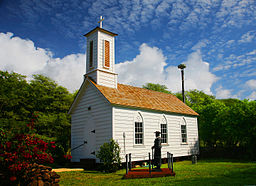
Finding Molokai Records
Records pertaining to people with leprosy who were deported to the island of Molokai are housed at the State of Hawaii’s Hansen’s Disease Branch. They can be reached at:
State of Hawaii Dept. Of Health Hansen’s Disease Branch 3627 Kilauea Avenue, Room 102 Honolulu, HI 96816 Phone: 808-733-9831 Michael Maruyama
The records typically contain name, age, and date sent to Molokai. They may also include the names of parents and siblings or others from the family who were sent to Molokai. It is important to note that many people refused to be deported to Molokai. They could not fathom being separated from their loved ones. Although in some cases a relative could be brought along if designated as “Helper”, this was not the rule. In most case, healthy family members were forbidden from joining their loved ones on Molokai. Some awaiting deportation hid in the wilds near their homes. Others assumed fake identities and migrated to California. There appears to be no record of those who were supposed to go to Molokai but never got there.
Note: Thank you to reader, Jody Schooley, who provided the contact information for obtaining these records. This information is accurate as of October 2015 and updates the information that was previously provided in this article.
Some Numbers:
Size of Molokai: 260 Square Miles Size of Kalawao: 800 acres
Number of Patients on Molokai:
1866–115 1880–1,000 1908–791 (693 were Hawaiians, 42 Chinese, 26 Portuguese, 6 Americans, 5 Japanese, 6 Germans, and 13 of other ethnicities Total deportees to Molokai: approximately 8,000
Note : The use of the term leprosy in this article is meant to reflect the historical era in which the term was used. It is not used in anyway to offend anyone.
There are several books that cover this period in Hawaii’s history. There are histories as well as fictional accounts such as Alan Brennert’s Molokai. The more we learn the more we understand what it might have been like to learn you had leprosy before there was a cure.
- Father Damien . Catholic Online Catholic Encyclopedia Digital version.
- Kalaupapa [pamphlet]. Kalaupapa National Historical Park, National Park Service, U.S. Department of the Interior.
- NPS Kalaupapa Settlement website .
- Pioneers of the Faith: History of the Catholic Mission in Hawaii, by Robert Schoofs. Sturgis Printing Co. : HI, c1978.
- Shoal of Time: a History of the Hawaiian Islands, by Gavan Daws. University of Hawaii Press : Honolulu, HI, c1968.
- Webster’s New World Dictionary of the American Language. Simon & Schuster : NY, 2nd College Edition, c1982.
© 2002-2015 Melody Lassalle
There's More To Read:

Share this:
Leave a reply cancel reply.
This site uses Akismet to reduce spam. Learn how your comment data is processed .

ABOUT MOLOKAI – The Kalaupapa Lepers and Saint/Father Damien
Kalaupapa – Shaped somewhat like a fish (the locals say a shark) has its head facing east, its tail in the west and a dorsal fin rising from its back on Molokai’s north shore.
That dorsal fin is the nearly flat, ten-square-mile (25.9 sq km) Makanalua Peninsula which juts into the Pacific below the world’s highest sea cliffs. A place of stunning beauty, it’s been blessed by nature’s grandeur, and cursed by humanity’s ignorance and fear.
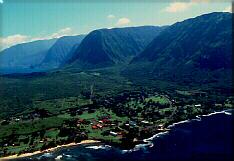
While this area is generally referred to as Kalaupapa, in fact, Makanalua Peninsula is divided into three districts: The Kalawao district on the eastern edge; Kalaupapa and the settlement of Kalaupapa to the west; with Makanalua in the center.
Inhabited from about 650 AD, the Hawaiians fished the rough surrounding ocean by outrigger canoe with nets and spears for over 1200 years .
They also farmed the land, coaxing sweet potatoes, onions and taro from the harsh volcanic soil. With the vines of the sweet potato, their main vegetable, they fed their pigs, which in turn they used to barter with other villagers in the eastern valleys.
While the peninsula was not largely settled, it was traveled much and used extensively. The entire area is divided and subdivided by low rock walls that continue for mile after mile, creating thousands of small lots of every imaginable shape.
There is no written history of the people who built them; historians theorize that they were constructed as pens for raising pigs, as windbreaks for growing crops and possibly as property boundaries and land divisions.
The early Hawaiians built fishing shrines called heiau as places to make offerings for their safety while fishing in the rough waters that surrounded the peninsula. These heiau were platforms built of stone in circular and square shapes. Some of their surfaces are filled with coral, while others have elaborate enclosures lined with flat rocks on which offerings of fish or shells were placed.
Today, the trail from Topside Molokai to Kalaupapa is traveled by mule, by hikers, and on foot by some of the workers at the settlement. There is also a small airstrip at the northern edge of the peninsula, used daily to bring in food, supplies and visitors.
Hugging the nearly perpendicular cliffs, the trail is over three miles (5km) long and descends 1,600 feet (488m) to the peninsula. Along its course are 26 switchbacks that corkscrew in and out of canyons and ravines.
Once a year in the summer, when the seas are calm, a barge from Honolulu anchors at Kalaupapa, delivering thousands of pounds of rice, cases of beer, drums of gasoline and supplies to stock the grocery store and hospital.
Kalaupapa’s reputation as a leprosy colony is well-known. Hansen’s disease, the proper term for leprosy, is believed to have spread to Hawaii from China. The first documented case of leprosy occurred in 1848. Its rapid spread and unknown cure precipitated the urgent need for complete and total isolation.
Surrounded on three sides by the Pacific ocean and cut off from the rest of Molokai by 1600-foot (488m) sea cliffs, Kalaupapa provided the environment.
In early 1866, the first leprosy victims were shipped to Kalaupapa and existed for 7 years before Father Damien arrived.
The area was void of all amenities. No buildings, shelters nor potable water were available. These first arrivals dwelled in rock enclosures, caves, and in the most rudimentary shacks, built of sticks and dried leaves.
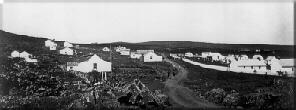
Taken after Damien had constructed most of the houses seen here, this photo shows the stark, barren peninsula and settlement at Kalawao in the 1880s.
Folklore and oral histories recall some of the horrors: the leprosy victims, arriving by ship, were sometimes told to jump overboard and swim for their lives. Occasionally a strong rope was run from the anchored ship to the shore, and they pulled themselves painfully through the high, salty waves, with legs and feet dangling below like bait on a fishing line.
The ship’s crew would then throw into the water whatever supplies had been sent, relying on currents to carry them ashore or the exiles swimming to retrieve them.
In 1873, Father Damien deVeuster, aged 33, arrived at Kalaupapa. A Catholic missionary priest from Belgium, he served the leprosy patients at Kalaupapa until his death. A most dedicated and driven man, Father Damien did more than simply administer the faith: he built homes, churches and coffins; arranged for medical services and funding from Honolulu, and became a parent to his diseased wards.
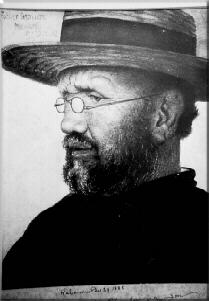
Shown here in a rare pencil sketch from December, 1888, Damien contracted the disease, and after 16 years of selfless service, died in 1889.
In 1886, Brother Joseph Dutton arrived at Kalaupapa to assist Father Damien. Dutton, an energetic and dedicated missionary priest, assumed many of the duties Damien was unable to perform as his leprosy progressed.
Mother Marianne, another revered servant, devoted 29 years on the peninsula as an administrator, nurse and educator. She spent her life on the go, even as her age climbed well into the seventies. She died in 1918.
In 1977, Pope Paul VI declared Father Damien to be venerable, the first of three steps that lead to sainthood. Pope John Paul II declared Damien blessed in 1995, and in October 2009 he will be canonized as a saint.
With the advent of sulfone drugs in the 1940s, the disease was put in remission and the sufferers are no longer contagious. The very few former patients remaining on the peninsula are free to travel or relocate elsewhere, but most have chosen to remain where they have lived for so long.
While Kalaupapa is now a National Historic Site, it is also the home of the few former patients who choose to remain there. So access, is by law, strictly regulated.
Unless you are invited by one of the residents, you must take the tour offered by Damien Tours of Kalaupapa (about $60.00). The peninsula can be reached by air or by way of the trail descending the 1,600-foot-high (488m) cliffs. Visitors can hike in and out at no cost or ride one of the Molokai mules, which will add about $125 to the cost. Visitors must be at least 16 years old.
The peninsula’s terrain is flat: Translated, Kalaupapa means “level land resembling a flat leaf.”
Strong northeast trade winds and a lack of sufficient rainfall make for harsh living conditions. The nearby cliffs receive more than 25 feet (7.6m) of rain annually, but it disappears through the porous ground. At the near edge is the settlement of Kalaupapa, the only town on the peninsula. At the far edge is the district of Kalawao.
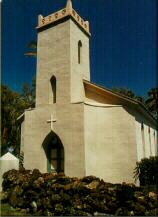
Father Damien added on to St. Philomena twice, more than doubling its size. To accommodate the needs of his congregation, Damien positioned the church so that the gusty trade winds passed through the many windows.
The interior of St. Philomena was refinished and painted by his parishioners. Because of their fondness for bright colors, they selected a rainbow of colors to complete the task.
In 1995, following the beatification ceremonies in Belgium, a relic of Father Damien was returned to Kalawao and was reinterred next to the church. Today, St. Philomena stands in homage to Damien the Blessed, the priest from Belgium. A black, concrete cross marks Father Damien’s grave site at Kalawao. It was Damien’s wish to be buried among his people at Kalawao. Finally, his wishes were respected.
- Skip to primary navigation
- Skip to main content
- Skip to footer
Travel with a Challenge
Richly-illustrated senior travel magazine website: nature, cruising, educational, cultural and volunteer vacations.
Editor’s Note: Much of this article is effectively obsolete because the mule ride company has stopped operating and the Kalaupapa National Historic Park is not presently open to the public even if visitors could continue to use the mule trail for hiking from the cliff top or they could arrive at the national park by boat or sea plane. However, instead of eliminating this adventurous, educational article from our Travel Article Library collection, I am keeping it in place for now with the hope that entry to the national park will be restored and that some enterprising operator will revitalize the extraordinary mule ride access as described in the article. Meanwhile, there is much to see and do on the island of Moloka`i in addition to the events and there are interesting places to stay as you will find in other pages of our wide-ranging and in-depth Hawaiian Islands collection of articles.
Molokai Mule Ride to Leper Colony

Mules prepare for another day on the cliff trail to Kalaupapa. Alison Gardner
Visit molokai leper colony, by alison gardner.
There was a time when the only way to get to Kalaupapa was to be sent there. If that sounds like a prison, the maximum security image is an accurate one. The ticket for entry was what the Hawaiian’s named “the separating sickness” : leprosy or Hansen’s Disease. Each person’s sentence was for life.
In the 21st century, there are three ways to visit Moloka’i’s Kalaupapa Peninsula – by mule, by foot (a vigorous hike to be accomplished both ways in one day) or by small plane. The Molokai Mule Ride is the most original way to arrive and the most famous, so famous, in fact, that it requires only the simplest web address, www.muleride.com . However you choose to arrive in the historic leprosy settlement, you will be fully escorted from that point on until you leave later in the day. It is an exquisitely beautiful peninsula with a harrowing history and a surprisingly gentle, uplifting ending. As Robert Louis Stevenson eloquently declared following his own visit in 1889, he witnessed “beauty springing from the breast of pain.”
But first …. It’s time to climb up on my trusty mule for the trail ride down 1,700 feet of the spectacular cliff face, 2.9 miles and 26 very tight switchbacks to navigate. Hawaiians usually have a great sense of humor and our head guide, Bobby, proved to be no exception. He took one look at my blonde hair and almost translucent skin and smiled, “You can have Ilikea. You’ll remember the name because it means light skin or white in Hawaiian.” Yes, Ilikea was the only snow white mule there.

Mule ride with Kalaupapa. Maui Visitors Bureau (MVB)
The mule ride.
After a briefing so full of one-line jokes that we could hardly focus on the serious instructions, each person swung into our mule’s saddle. The mules immediately went from loose-limbed, flat-earred dozing to fully alert, ears forward and ready to go. Since they navigate this trail most days year round, it’s best to let the mules rule warned Bobby, adding that this is hardest for experienced riders to do because they keep wanting to steer, brake and toot the horn.

Mule ride trail through woods. Alison Gardner
Several years ago, the National Park Service made the trail easier for hikers and less subject to erosion by installing steps along most of the two hour ride. However, this initiative is definitely a disadvantage for mules and riders as each step means a jarring thump to the next level. Anyone with back problems should select another option for getting to Kalaupapa. For the rest of us, the challenge of taking photos on a moving animal navigating a staircase needs no further description. I soon put the camera away and focused on the scenery.
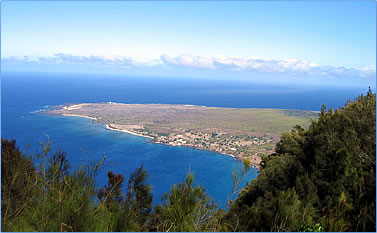
The Kalaupapa Peninsula from a 2,000 foot cliff, which has earned Moloka’i a place in the Guinness Book of World Records as having the tallest sea cliffs in the world. Alison Gardner
Two thousand foot sea cliffs creating the perfect escape-proof wall, narrow lush valleys, verdant rainforest, lava tubes and caves, fine sand beaches, off-shore islands and coral reefs are all visible within the national park boundary while switchbacking down the trail. Several physically isolated areas provide rare native habitat for threatened or endangered Hawaiian plants and animals like the Hawaiian monk seal which births on Kalaupapa’s beaches. Remnants of native ecosystems can be found along the windward shoreline and in the uplands. In these cases, inaccessibility has proved to be a blessing.
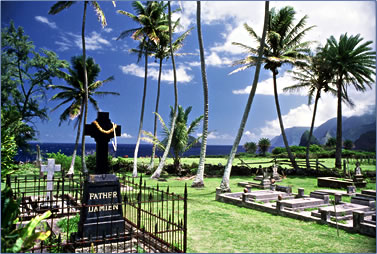
The Kalaupapa Settlement Visit
Kalaupapa National Historic Park is open Monday through Saturday by invitation only. Being in a tour group ensures that invitation. The park rangers are serious about this, with fines of $500 if you decide to take to the trail on your own. Why? The priority at this time is the privacy of the remaining 14 residents who once had leprosy but do so no more having undergone successful treatment with sulfone drugs long ago.
Since residents presently range from their mid-60s to mid-90s in age, controlled access to the park could remain in place for some time.
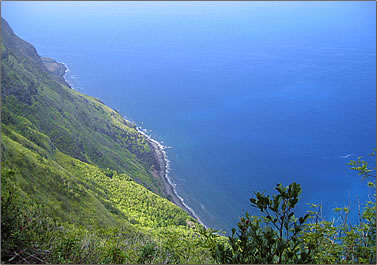
This view from the back of my mule, Ilikea, shows free-fall distance to the sea. No casualties yet! Alison Gardner
No matter how you arrive on the Peninsula, it is a Damien Tour, owned by settlement residents, that meets each group and escorts visitors around the peninsula. An orange and black striped school bus minus its shock absorbers rolled up to our mule corral as we dismounted and hobbled around finding our land legs after the two hour ride. Our picnic lunches were loaded on board the bus and we set off to explore. In this community hidden from the world until recent decades, we learned how life was lived in the former leper colony, and how individuals sacrificed their personal lives with courage and love.
We visited the many historic landmarks in both Kalaupapa town and largely deserted Kalawao on the north shore of the peninsula, landmarks maintained and being renovated under the park’s management. Kalaupapa today is a place of education and contemplation with a natural backdrop of bays and velvet green mountains that conjure up images of tropical paradise as it never did for those dropped ashore or even thrown off sailing ships to swim if they could, then live and die in misery.
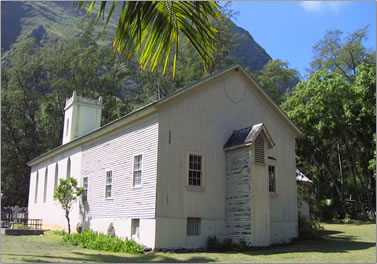
St Philomena church at Kalawao is undergoing much needed renovation inside and out. Alison Gardner
Thinking about paradise during my 2009 visit, my mind turned to the news that certainly had the Kalaupapa community abuzz …. 120 years following his death at Kalaupapa, the Vatican canonized Father Damien as a saint of the Catholic Church in mid-October 2009. Saint Damien it is! Some residents, the majority of whom are Catholic, even journeyed to Rome for the ceremony. Having encountered a number of pilgrimage destinations in my travels, I can easily visualize how faithful people inspired by pilgrimage travel will desire to come and see this remarkable place in person. Clearly, they must come to paradise in very small numbers “by invitation only” and stay only part of a day, but the experience will touch each heart nevertheless, as it did mine.
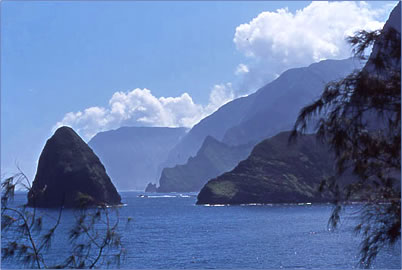
Northshore Kalaupapa, the view from Kalawao. MVB
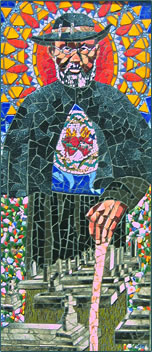
Alison Gardner is a travel journalist, magazine editor, guidebook author, and consultant. She specializes in researching vacations throughout the world, suitable for people over 50 and for women of all ages. She is also the publisher and editor of Travel with a Challenge Web magazine, www.travelwithachallenge.com . Email: [email protected]
Feel free to explore other stories about alternative Hawaiian vacations well suited to senior travelers, their families and friends. Click on the titles below to read each inspiring article. Alternative Hawaii Maui’s wine, goats and lavender Lana’i moves slowly into tourism Hawaiian Islands volunteer vacations Maui’s most Hawaiian hotel Hawaii’s tasty cultural cuisine Hawaii tour operators and planners Hawaii – sleeping in paradise Language and culture Hawaiian bird pictures Hawaii wellness vacationing Hawaii’s wellness providers Diamond Head Maui Zipline Adventure
Web Magazine & Privacy Policy
Connect with us.
- Skip to global NPS navigation
- Skip to this park navigation
- Skip to the main content
- Skip to this park information section
- Skip to the footer section

Exiting nps.gov
Alerts in effect, a brief history of kalaupapa.
Last updated: December 19, 2022
Park footer
Contact info, mailing address:.
P.O. Box 2222 7 Puahi Street Kalaupapa, HI 96742
808 567-6802
Stay Connected
- Molokai Tourism
- Molokai Hotels
- Molokai Bed and Breakfast
- Molokai Vacation Rentals
- Flights to Molokai
- Molokai Restaurants
- Things to Do in Molokai
- Molokai Travel Forum
- Molokai Photos
- Molokai Map
- All Molokai Hotels
- Things to Do
- Restaurants
- Vacation Rentals
- Travel Stories
- Rental Cars
- Add a Place
- Travel Forum
- Travelers' Choice
- Help Center
Kalaupapa Leper Colony Tour - Molokai Forum
- United States
- Hawaii (HI)
- Molokai
Kalaupapa Leper Colony Tour
- United States Forums
- Europe Forums
- Canada Forums
- Asia Forums
- Central America Forums
- Africa Forums
- Caribbean Forums
- Mexico Forums
- South Pacific Forums
- South America Forums
- Middle East Forums
- Honeymoons and Romance
- Business Travel
- Train Travel
- Traveling With Disabilities
- Tripadvisor Support
- Solo Travel
- Bargain Travel
- Timeshares / Vacation Rentals
- Hawaii forums
- Molokai forum

Hi, We are going to spend a week on Molokai in February. We have read about the leper colony and understand the mule trail is closed due to a mud slide. I have been reading reviews and trying to get through to a couple of the tour agencies that are licensed to do the tours. I see there is a Damien Tour LLC, this number has a voice mail that is full. Then there is another one that I have seen named Kauluapapa Rare Adventure and Kekaula Tours with the same number. They did answer the phone; but, I am seeing some bad reviews for this one(I think). We have two friends that say they had a wonderful guide named Rick Schonely; but, I am not sure how to get him as a guide. Any recommendations? Also, any other must see recommendations while we are in Molokai? Thank you for your help.

Rick works with muleride.com
You can check him out on Facebook.
Not sure what days he works but he has guided tours recently.
https://www.facebook.com/rick.schonely

muleride.com offers fly in tours. I used them for the hike a couple years ago, and they are a legit company. Rick Schonely was my guide, and he is fantastic. Back then, he worked Mondays and Tuesdays as the guide, but of course, that could have changed by now.
This topic has been closed to new posts due to inactivity.
- Maui to Molokai Daytrip Mar 09, 2024
- Donations Feb 18, 2024
- Macadamia Nuts? Feb 17, 2024
- Massage on island Feb 11, 2024
- Molokai Business Trip Jan 31, 2024
- Small cruise line coming to Molokai? Dec 07, 2023
- Molokai in April — calm Nov 26, 2023
- Molokai has a New Molokai History Project Museum Oct 14, 2023
- Visit to Molokai Jul 24, 2023
- Is Mokulele the ONLY way to/from Moloka'i? Jul 12, 2023
- Car rental Jul 04, 2023
- Bring SUP to Molokai? Jun 24, 2023
- Hike to Pu'uka'oku Falls Jun 24, 2023
- Hoping to go to Molokai Jun 24, 2023
- One day trip to Molokai?? 18 replies
- Our stay on Molokai 11 replies
- Moving to Molokai - insights 37 replies
- Maui to Molokai by ferry...is it really a ROUGH trip??? 7 replies
- scooter rental 4 replies
- Aloha sunset cottage and Molokai aloha beach house 4 replies
- Flights from Honolulu to Molokai 10 replies
- Best part of the island to stay on 3 replies
- What does "Molokai" mean?? 48 replies
- Snorkeling 6 replies
Molokai Hotels and Places to Stay
- Staying safe in Hawai`i

IMAGES
VIDEO
COMMENTS
Once you have booked your tour and obtained your permit, it's time to decide how you want to get to the Molokai leper colony. You have three options: On Foot: Hike down the Kalaupapa Cliffs. The trail to Kalaupapa descends 26 switchbacks with a nearly 2,000-foot elevation change over 3.5 miles.
One of the adventures we had back then was to hike down to the leper colony on Molokai and join the tour of the Kalaupapa peninsula. Back then, you were able to either hike down or take a mule ride down the 2.9-mile Kalaupapa trail with 26 switchbacks, a descent of 1700 feet on the edge of the tallest sea cliffs in the world! ...
The trail down the sea cliffs to the Molokai leper colony was created in 1988 and is maintained by the National Parks. When I went in 2015, I chose to take the mules because I heard about the exciting (sometimes harrowing) experience of riding the mules down 1700 feet and 26 narrow switchbacks.
When Hansen's disease (leprosy) was introduced to the Hawaiian Islands, King Kamehameha V banished all afflicted to the isolated Kalaupapa Peninsula on the north shore of Molokai. <br /><br />Since 1866, more than 8,000 people, mostly Hawaiians, have died at Kalaupapa. Once a prison, Kalaupapa is now a refuge for the few remaining residents who are cured but were forced to live their lives in ...
What to expect: Extremely friendly people (and mules), beautiful scenery, pictures/video that will have everyone saying WOW and an emotionally moving tour of a leper colony. The ride is exciting, but very safe; the big guys are exceptionally sure footed, the trail is well maintained and the guides are experts.
The park was established in 1980 to preserve the memories and experiences of the people forcibly sent here. The park's mission is to provide a well-maintained community that ensures the present patient-residents of the Kalaupapa Settlement may live out their lives peacefully and comfortably. The park also supports education concerning Hansen's ...
After hiking down the trail we paid the tour guide and signed in on the tour bus before the tour began. The flyers, mule riders and hikers all ride the same bus to tour Kalaupapa and Kalawao, which is the original leper colony settlement about 5 miles west on the opposite side of the peninsula.
For four years, ever since I read the historical novel Molokai by Alan Brennert, I've wanted to visit Kalaupapa for myself. I couldn't believe I had never heard of this leper colony. I couldn't believe people still got leprosy as recently as 150 years ago. I couldn't believe people still get leprosy. Hawaii has fascinated me for years, but I'd never heard of Kalaupapa or the leprosy colony there.
The site of an 1860s leper colony on Molokai island draws determined travelers. By M. L. Lyke. November 2, 2017 at 9:00 a.m. EDT. Leprosy patients sometimes had to swim to shore from the cone ...
I was a thirteen-year-old kid. Male, part-Hawaiian, c. 1977-78. On January 6, 1866 the first group of, 12 patients, arrived at the settlement for isolation. 11 of them died within the first five years in exile. Kalawao, on the east side of the peninsula, was the site of the initial leper settlement.
Unnamed Rd, Kalaupapa, Molokai, HI Directions: Kalawao Park. Pick up your mule on Hwy 470 (Kalae Hwy) at mile post 5. Look for the large Molokai Guided Mule Tour sign. Hours: Tours must be booked in advance. (Call to verify) Local health policies may affect hours and access. Phone: 808-567-6171 RA Rates: Worth a Detour
Fear of an Epidemic. The first case of leprosy (a.k.a. Hansen's disease) was documented in Hawaii in 1835. The person lived in Koloa, Kauai. 1863 was the year that leprosy grew into an epidemic in the Hawaiian Islands. In 1865, the legislature passed the "Act to Prevent the Spread of Leprosy". Soon after, King Kamehameha V issued a decree ...
436. Entrance to the colony Mark Shepherd/Public Domain. Cut off from the rest of the world by 1,600-foot cliffs on one side and ocean on the other, Kalaupapa on the island of Molokai, is a ...
One of the adventures we had back then was to hike down to the leper colony on Molokai and join the tour of the Kalaupapa peninsula. Back then, you were able to either hike down or take a mule ride down the 2.9-mile Kalaupapa trail with 26 switchbacks, a descent of 1700 feet on the edge of the tallest sea cliffs in the world!
Molokai Mule Ride: Trip by air into the Leper Colony was worth the extra $$. - See 290 traveler reviews, 253 candid photos, and great deals for Kalaupapa, HI, at Tripadvisor.
Unless you are invited by one of the residents, you must take the tour offered by Damien Tours of Kalaupapa (about $60.00). The peninsula can be reached by air or by way of the trail descending the 1,600-foot-high (488m) cliffs. Visitors can hike in and out at no cost or ride one of the Molokai mules, which will add about $125 to the cost.
In this episode of A Broad Abroad, Paula Froelich gets a rare tour of Molokai Island's remote Kalaupapa village, where thousands of Hawaiians with leprosy li...
The ticket for entry was what the Hawaiian's named "the separating sickness" : leprosy or Hansen's Disease. Each person's sentence was for life. In the 21st century, there are three ways to visit Moloka'i's Kalaupapa Peninsula - by mule, by foot (a vigorous hike to be accomplished both ways in one day) or by small plane.
The 20th Century: 1900 - 1945. Starting in 1900 the Board of Health implemented a plan to provide high quality services, facilities, utilities, and medical care for patients at Kalaupapa. A major construction program began, with individual cottages, dormitories, hospital facilities and other buildings being built.
Kalaupapa Leper Colony Tour. 4 years ago. Save. Hi, We are going to spend a week on Molokai in February. We have read about the leper colony and understand the mule trail is closed due to a mud slide. I have been reading reviews and trying to get through to a couple of the tour agencies that are licensed to do the tours.
Kalaupapa National Historical Park is a United States National Historical Park located in Kalaupapa, Hawaiʻi, on the island of Molokaʻi.Coterminous with the boundaries of Kalawao County and primarily on Kalaupapa peninsula, it was established by Congress in 1980 to expand upon the earlier National Historic Landmark site of the Kalaupapa Leper Settlement.
Kalaupapa village was founded in 1866 for those suffering from Hansen's disease, also known as leprosy. Mandatory isolation ended in 1969. Things began to change when a cure for Hansen's disease ...
Kalaupapa postmark Kalaupapa Peninsula as seen from a descent down the sea cliffs The Kalaupapa Leper Settlement. Kalaupapa (Hawaiian pronunciation: [kəlɐwˈpɐpə]) is a small unincorporated community and Hawaiian home land on the island of Molokaʻi, within Kalawao County in the U.S. state of Hawaii.In 1866, during the reign of Kamehameha V, the Hawaii legislature passed a law that ...